#and i think about his expressions in that comic vs his corpse and what we retroactively knew he was dealing with a lot
Explore tagged Tumblr posts
Text
I've been following @druidposting's DR2 playthrough on discord and we just had a really good discussion about DR's Closing Arguments. Specifically the way the murderer is depicted as grey and featureless, which until now I found a bit annoying.
In Danganronpa it's repeatedly the case that we don't have the full picture until the talking actually stops- which always goes beyond the end of the trial. We generally vote first and come to understand what the murderer's actual motive was, sometimes filling in important pieces of the timeline in the process, afterwards.
But none of that matters for the killing game because characters' emotions aren't directly relevant to who was the 'blackened'- the only thing that matters to Monokuma- so it comes out afterwards and does nothing to change their execution. It doesn't matter how sympathetic they are (basically everyone) or whether other people share responsibility for the situation (eg. Hanamura, Pekoyama, Momota) or whether they intended to murder at all (Nanami). They objectively pulled the trigger and nothing else matters. Nothing about them as a person matters.
The Closing Argument mechanic might illustrate that problem- literally. They're a dramatic, conclusive summary of the entire case... constructed before the vote even happens, before we know if we're actually right, and they're missing something really important:

The actual perpetrator.
We quite literally don't even begin to see the real person behind the crime, any real exploration of their mental state, anything besides the cold, hard facts of the murder that are necessary to convict them, until the comic finishes and the protagonist makes their final accusation- replacing the grey figure with their real appearance in a shot that's often intensely emotional.
And these comics lack crucial parts of the case's timeline and sometimes important parts of the very scenes they depict that we only find out about afterwards. And those are what we know; characters may die with some pieces of the truth and prevent us from ever learning them. These aren't objective depictions of the murder, they're the protagonist's subjective attempt to connect the facts they have. A join-the-dots portrait of someone with missing dots and no colour.
Even characters' expressions may not match how they truly feel, with the grey placeholder potentially looking way more confident and sinister than they were in reality. Pasting Falter's commentary here since they put it well.

For obvious reasons this could especially be a problem for characters that die before the trial- the ones we never get a post-vote testimony from. DR1 chapter 4 really highlighted that in the way Asahina's huge misinterpretation of Oogami's feelings took up a lot of the post-trial discussion, only for Monokuma to reveal Oogami's real suicide note and recontextualise everything.
It might really be a problem for how Komaeda's depicted in DR2 chapter 5. While he isn't greyed out, we get panel after panel where he's either level-headed or maniacally evil, and even the depictions of his self-torture and death don't humanise him:





But we know that his real feelings were more complicated than that. We have his actual corpse to compare the last page to.
He died afraid.

If we approach the comic as Hinata's mental image of him instead of reality, he died without anyone truly understanding him. He was alarming, very hard to relate to, actively fought against people doing so, ensured even the killer didn't watch him die, and the survivors couldn't begin to understand his motive until a chapter later. The Closing Argument reflects that.
Early in DR1 Togami calls out the rest of his class for judging others by their own standards. However, he, too, is doing this, maybe more so than many other characters; his inability to view other people through anything but the cold, brutal logic of the killing game bites him in the ass in chapter 4. In DR2 chapter 2 voting without a good understanding of Pekoyama's motive or Kuzuryuu's involvement nearly got everyone killed. Komaeda's a walking embodiment of the problems with flattening people into caricatures and not empathising with them, suffered from people doing that back to him, and his case- the Closing Argument for which turned everyone else into grey placeholders- was impossible to solve with objective facts. It was only survivable because the survivors cooperated and one person tried to analyse things the way he would.
The games have always been a critique of the justice system and Japanese society and push us to care about others as individuals, not reduce them to- and judge their right to exist by- something they've done or their net impact on society. There are always consequences when someone neglects to do that, and the above might be yet another way the games explore that theme.
#danganronpa#dr analysis#komaedology#komaeda#.txt#sorry @ non komaedaheads for making it about komaeda again LMAO#that was not the intention initially he's just... a really good exploration of this#and i think about his expressions in that comic vs his corpse and what we retroactively knew he was dealing with a lot#btw don't send spoilers to falter please!! i'm @ing to credit them- this was a discussion not solely my ideas- but they are not done yet#and aren't reading this post until they're caught up for obvious reasons#this came from discussing ch2 since the incomplete picture people voted with nearly killed them#(btw don't @ me about komaeda's description in the second-last paragraph being an oversimplification; i know :p )#(he has nuance- especially outside of the killing game- but i'm just focusing on the thematically relevant broad strokes here)#(eg. i feel like he demonstrates empathy sometimes but kodaka has said that lack of ability to empathise/be empathised with#is a theme for him- and the ways he's been proactive in the killing game consistently lacked regard for others' feelings/individuality#reducing them to interchangeable Ultimates(TM) instead. it's partly why he self-destructed while everyone else#was able to forgive themself and keep moving forwards imo. your worth being defined rigidly by objective contributions to society#does not mesh well with the idea of rehabilitating people who've destroyed the world before they could even start to improve it#and even if he did give them a chance at surviving he still succumbed to his own ideology in the end#killed himself for 'hope' and to be 'important' like he 'wanted' but died terrified and in pain and alone instead of fulfilled#man i wish 2.5's ending/postnwp canon in general dug into that ;-; )#ANYWAY ty for reading all that. i feel like i rambled a lot in this one. i have a headache now ghdkjsfgdsf
86 notes
·
View notes
Text
Sception Reads Cass Cain #21
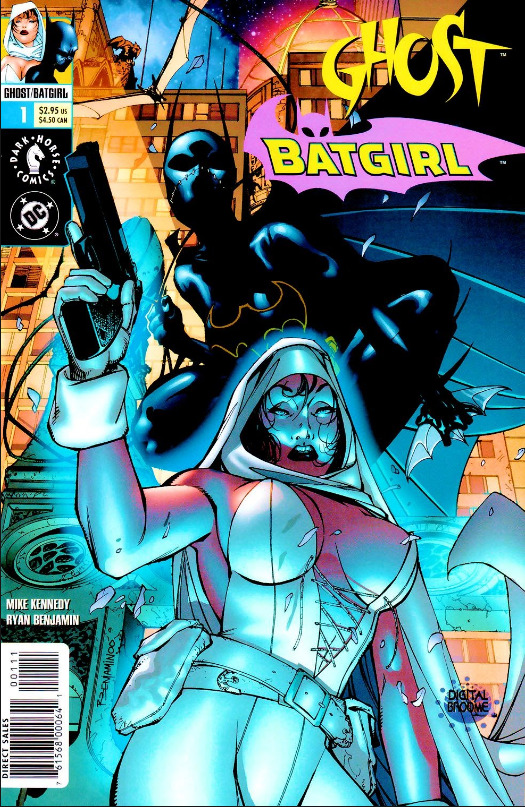
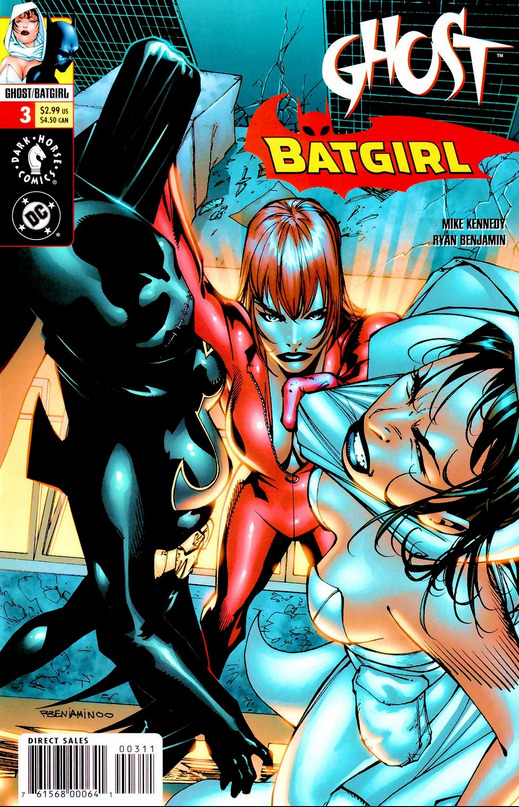

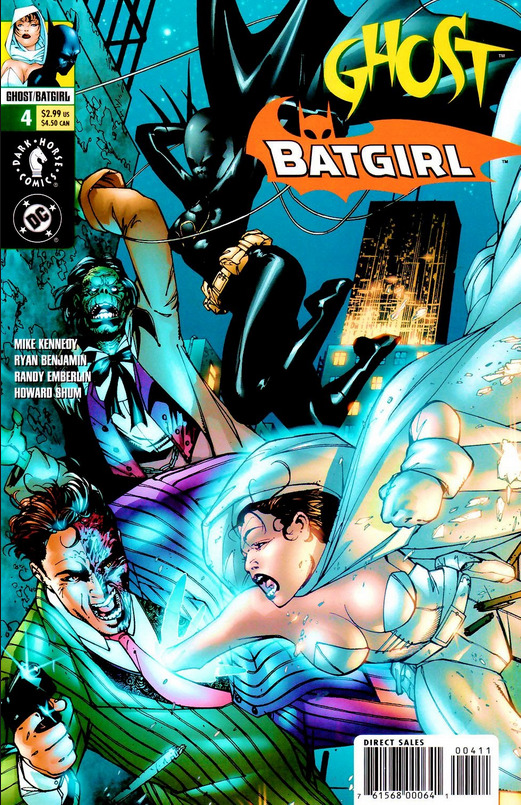
Ghost / Batgirl #1-4 Words: Mike Kennedy Pictures: Ryan Benjamin Additional Work: Randy Emberlin, Howard Shun
One impression I used to have that going back to look at ~all~ of Cass's early appearances has forced me to reconsider is the idea that she didn't appear outside of her own books very much. While later on that is more the case, early on she does have a fair few guest appearances and cross overs, including in this bit of non-canon dual publisher cross promotion with Elisa Cameron, aka Ghost, a Dark Horse character with a solo that had been running since 1995.
The miniseries pits long time Batman villain Harvey Dent against brand new Ghost antagonist Malcolm Greymater - a (fictional) confederate general turned zombie libertarian corpse reanimator - in a conflict over Greymater poaching some of Dent's employees (ie reanimating goons that Dent killed). Babs, Cass, and Elisa get caught in the middle and are forced to work together after following separate threads of a bombing by Two Face and bodies stolen by Greymater only to be sold off into unsavory employment after failed reanimation experiments.
I don't want to go through the whole thing with a plot summary - it's four issues of non-canon stuff after all. But as a stand alone story it works fairly well, worth a read if you're a fan of early Cass. In particular there's solid characterization of Harvey Dent and what it's like to work for him - pretty bad actually. You can see why he'd get upset at someone trying to poach his guys, working conditions for goons in Gotham are terrible, if word got around of better conditions in Arcadia (Ghost's hometown) or wherever else then Batman's villains could easily find themselves suffering a labor shortage. The mere idea of that is funny enough to me that I can't help but like this little mini series, and it's an idea I'd love to see brought back. Goons On Strike - now there's a solid idea for an ongoing Gotham event crossover.
Anyway, Ghost/Batgirl is definitely a higher fantasy story than we usually see from Cass, at least back in the early days, but there's a focus on the individual lives and humanity of the underlings working for the villains that's very grounded and down to earth. That fits in really well next to the "street level" focus of Cass's early solo title. As for the book's cross-promotional function, it does make me curious about Ghost, though probably not enough so to go back and look at her solo title. I like her villain here, but Malcolm Greymater and his crew seem to be more or less exclusive to this crossover? Comicvine is telling me he maybe appears in a single issue outside of this, so that's kind of disappointing.
So setting aside the story, how's our girl in this? Well, first of all, she's being drawn by new hands. In costume she's mostly fine.
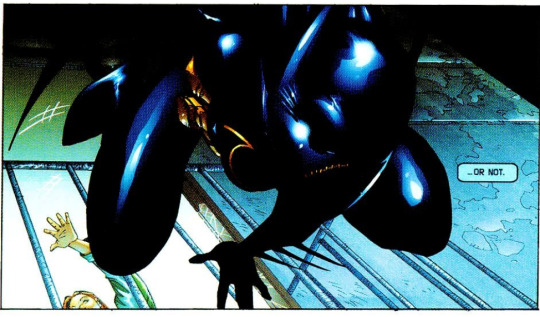
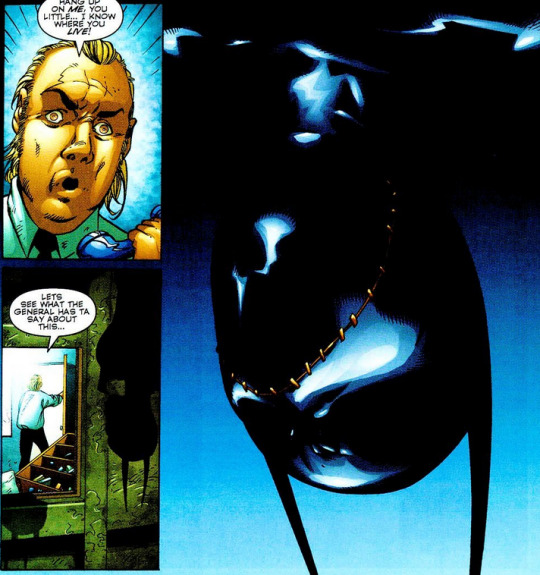

Sleek and spooky, glossy black. The details of her form are sometimes lost in the darkness, which loses some specificity in the action panels, but in a way that mostly works aesthetically. My only real complaint here is that her facial expression doesn't really show through the mask. You don't get a sense of what she's thinking or feeling in costume, she's just this dark angry spooky form, not so much a person or a character. As I've said in the past, though, that's as much or more a criticism of her costume design as it is of how any particular artist draws her in it.
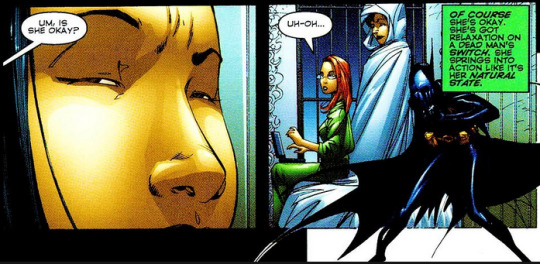
It's also worth noting that, as with Cass's early pairing with Azrael, her costume contrasts very nicely with Ghost's. White with round hood and billowing cape vs. Cass all black and pointy. Aesthetically it's a great fit.
Out of costume, though...

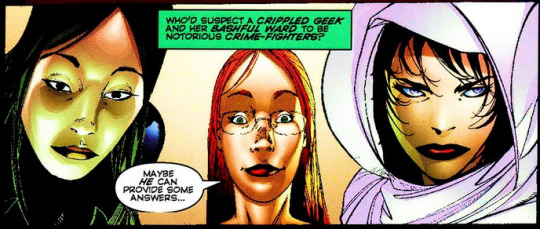
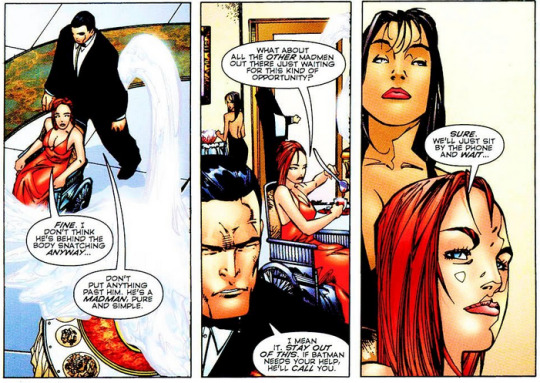

I don't know. Just doesn't quite look like Cass to me? I know, I know, comic character facial features don't have the same specific canon as their costumes do, different artists have different styles so characters will look different, and there's definitely a stylistic element here that isn't gelling with me. The overall shape of the head is too thin, maybe, making her look a bit older than she should, where I'm used to Scott's more rounded face, stronger jaw, bushier eyebrows, shorter, poofier hair.
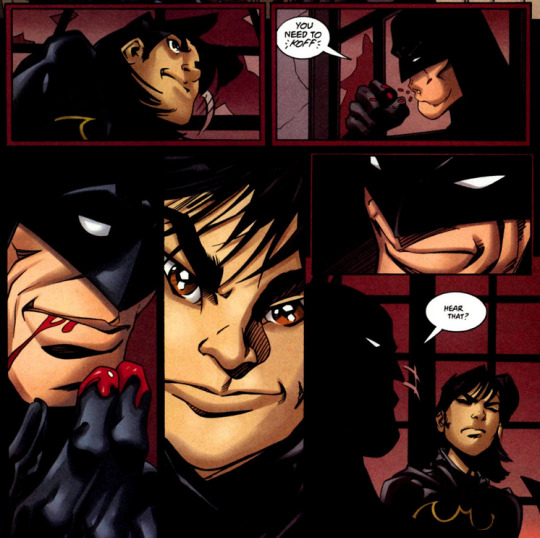
Scott's style, at least at the time, also just packs in more emotional expression, which is absolutely critical for a silent protagonist.
By contrast Benjamin's Cass, when she's not in costume, is often just standing a bit behind Babs with a sort of blank, neutral expression while Babs interacts with other characters or the audience for her.
...
Which also kind of brings us to the writing for Cass here. Ghost / Batgirl is probably the best example yet that silent Cass was a mistake, because yeah, the creators of this book just do not know how to convey her character to the reader without words. The first image starts with Cass looking out over the wreckage of a bombing, and of course there's pseudo noir internal monologue all over it, because how else do you start a bat-book, only Cass can't narrate so Babs provides the narration even though she isn't even in that scene.

Babs goes along on the adventure mostly so the writers have someone who can talk for Cass, or even in some panels quite literally talk over Cass.
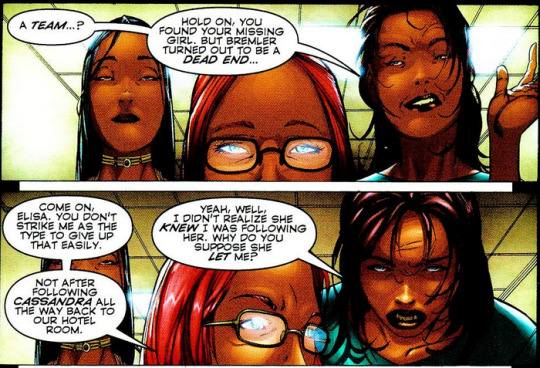
Cass is an intimidating physical presence in costume, but in this book she functions more as an extension of Babs than as a person in her own right.
...
It's not all bad, though. In particular there's this one bit introducing an additional ability for Cass that makes perfect sense with her backstory and yet sadly I don't think is ever mentioned again in a canon Batgirl story:
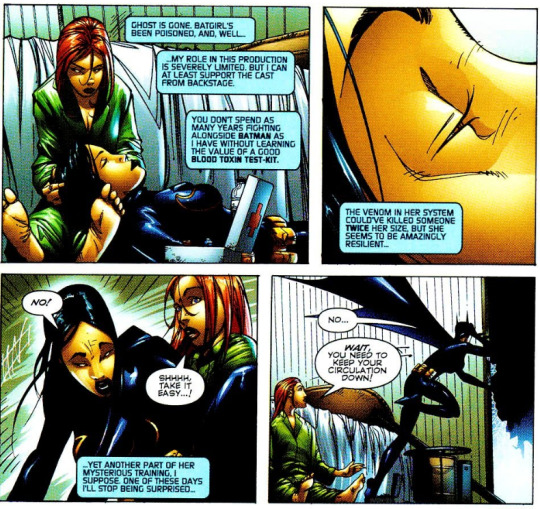
Cass gets poisoned, but she survives, and recovers remarkably quickly, because she has a natural resistance to many poisons and venoms built up from repeat exposure to tiny amounts when she was a child, because of course that's something David would do. You could just imagine little Cass and David having drinking contests to see who could take the most poison before passing out, or even sneakily poisoning each other as a little game of escalating pranks.
...
So yeah, overall a nice little stand alone series with maybe not the best depiction of Cass, but one that is illustrative of why the major change to have her start speaking, while I still don't like how it was done, was probably for the best.
34 notes
·
View notes
Photo
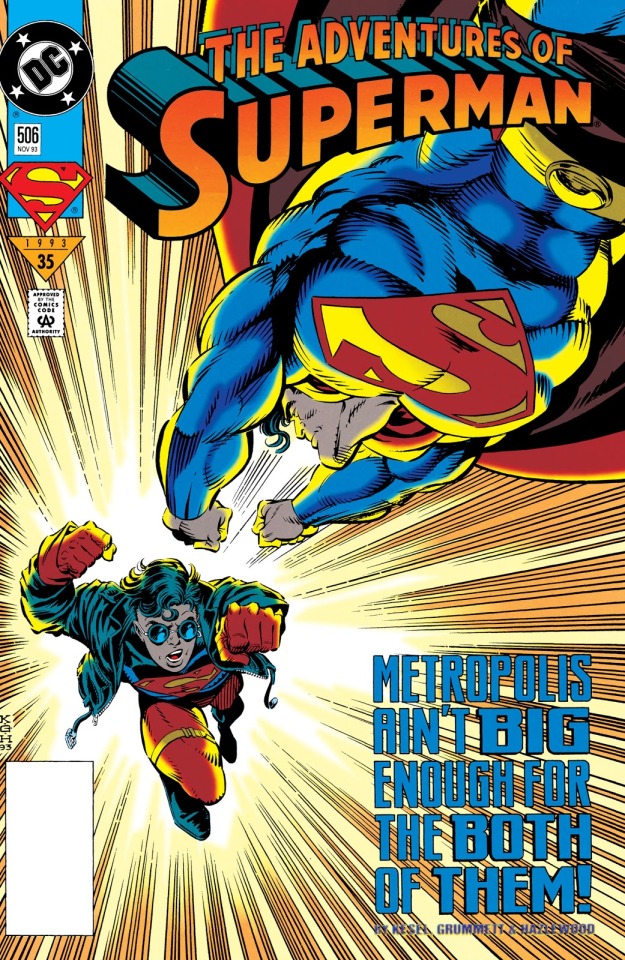
Adventures of Superman #506 (November 1993)
Superman vs. Superboy! I mean, vs. Superman, since the Kid still insists that Superboy is definitely NOT his name and never will be. The two Supermen meet while the younger, radder one is dealing with some sort of deformed flying babies that are trying to kill him, which is the sort of thing that happens to you when you wear an “S” emblem on your chest.

These turn out to be deformed flying babies THAT EXPLODE, but the Kid is able to push them away with his (very non-Superman-esque) telekinesis powers. He then deduces that these things must have come out of Project Cadmus, the top secret genetic experimentation facility that created him, and brushes off the elder Superman to get back at those geeks by doing what he does best: being a brat on live TV.

So I guess the “top secret” part of Cadmus’ description is no longer accurate, thanks to the Kid. On the other hand, I kinda feel like the people of Metropolis deserved to know that there's a nearby government facility churning out genetic atrocities into their sewers.
The Cadmus gang sends Guardian to bring their wayward creation home so they can talk to him. Obviously the Kid isn't very interested, and for a while it looks like we might get the fight scene teased in the cover, but then Superman the First convinces Superman the Second that he should at least hear them out. And, while at it, ask Cadmus to tell him exactly what the hell he is. If he’s Superman’s clone, why does he have those weird TK powers? The Kid agrees, but... he doesn't like the answers he gets.
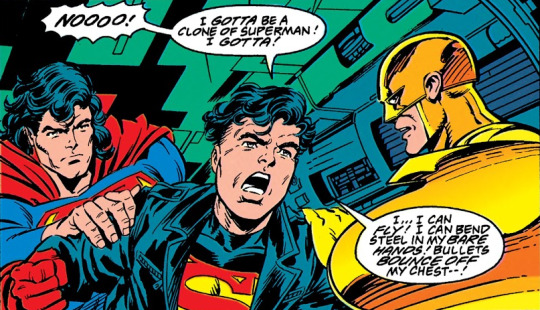
The Kid finds out that he's NOT a clone of Superman since, as established a while back, Kryptonians are damn hard to clone. So, since Cadmus was determined to create a new Superman after the original appeared to be dead, they instead took a clone of a regular, non-super man and genetically modified it to approximate Superman's powers (for instance, translating Superman’s “aura” into a telekinetic field). But who was that human DNA donor? Surely it was someone good and cool!
Just after the Kid wonders that, the quite evil and deeply uncool Director Westfield bursts into the lab and demands that this "super-punk" be taken into custody, probably so they can flush him down the toilet like Cadmus' other failed experiments. Superman makes Westfield see that making Cadmus' whistleblower disappear wouldn't look very good right now, but they can't just let him run around unsupervised. So, at Guardian's recommendation, the esteemed telepath Dubbilex is assigned to follow the Kid wherever he goes. I smell a sitcom! (Or a spin-off comic.)
As a last order of business, the Kid decides to give Superman his trademark to the Superman name, which his manager Rex Leech doesn't take too well. So what are they gonna call this teenage “S” emblem-wearing hero now? Superman has an interesting suggestion: SUPERBOY. Our young friend still isn't a fan.
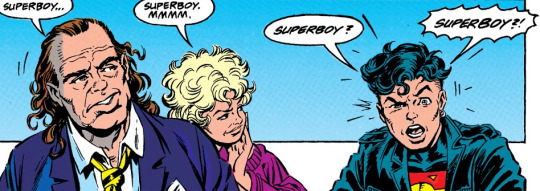
But after storming out and thinking about it for a couple of pages (and trying out the name on some guys robbing a jewelry shop), the Kid realizes he's "earned" the title of Superboy and accepts it. Character development! And just in time for his solo series. ("That Non-Superman Clone Who Also Calls Himself Superman" wouldn't look good on a cover.)
Plotline-Watch:
The final page shows a shadowy figure shaped like the recently introduced Bloodthirst outfitting someone with a weapon-teleporting gizmo, then calling him "Bloodsport"... except that this dude is quite paler than the Bloodsport we met way back in Superman #4 (in an issue inked by current writer Karl Kesel, so you'd think he'd remember the character). This looks nothing like Idris Elba! What gives?!
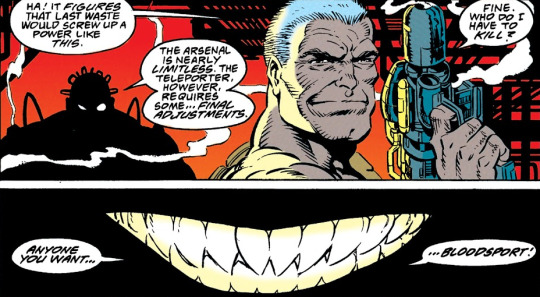
Superboy is still bummed out because his friend Tana Moon left Metropolis without telling him where she was going, which is now known as "ghosting". In the end, Rex talks about sending Superboy on a promotional tour to establish his new brand, and the first destination of that tour will be... exactly where Tana went to hide from Superboy. This is now known as "time to get a restraining order."
Clark Kent is slowly morphing into a hipster the longer he rooms with Jimmy Olsen. For a long time I assumed all the bands listed in the panel below were made up, but turns out the only non-existing ones are “James Rock” and "Axel Rose". Luckily, Superboy was happy to give Clark's old apartment back to him (apparently only Pulitzer-winning journalists can afford it), so Jimmy won't hipsterize him for much longer.

Westfield gladly assigns Dubbilex to Superboy because it means there won't be a telepath at Cadmus to read his thoughts and find out about his evil plans (like sending the ugly flying babies after Superboy). Very clever, Westfield! Except for the fact that he thought that right in front of Dubbilex, who clearly "heard" the whole thing.
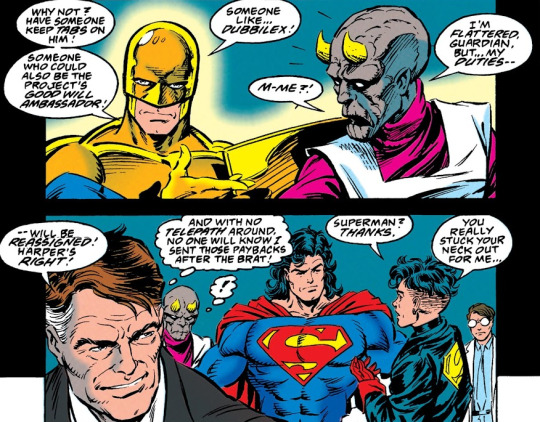
Incidentally, there's an apparent error in this issue when Superboy thinks "They won't take me without a fight!" and Guardian shows up and says "That's too bad, son. Because I don't want to fight you." How did Guardian know what Superboy was thinking? Obviously, Dubbilex patched Guardian through to Superboy's mind to assist in finding him. Now where's my damn Baldy Award?!
Is it me or is this page reminiscent of the cover to Superboy Prime's first appearance during Crisis on Infinite Earths?

Patreon-Watch:
Special thanks to your Patreon pals Aaron, Murray Qualie, Chris “Ace” Hendrix, britneyspearsatemyshorts, Patrick D. Ryall, and Samuel Doran, and welcome aboard to Bheki Latha (our first $6.50 patron ever!), Mark Syp, and Ryan Bush! You are all excellent. This month they got to read a long-ass post entitled 45 Things I Learned by Reading the “Death of Superman” Novel (Part 1), in which I talked about the stuff Roger Stern added to the canon in the first part of the Death and Life of Superman book. This includes Superman’s private thoughts on the JLI (and Guy Gardner in particular), what Lex Jr. calls Supergirl in bed, and Professor Hamilton getting romantic. Find out more at https://www.patreon.com/superman86to99
But now: the Don Sparrow show! Take it away, Don.
Art-Watch (by @donsparrow):
The end of an era, at least temporarily, as Tom Grummett draws his last Adventures of Superman issue, moving onto Superboy (and I think still doing Robin at this time?) with Karl Kesel. He’ll return for the quarterly Superman: Man of Tomorrow and other things, but it’s a long gap until he does.
A pretty good cover, with Superman and Superboy about to tussle. Though it can be seen as cheaping out on the backgrounds, I always love radial rays as an effect.
Inside the issue, we have a great splash page of Superboy getting attacked by botched clones, and I love the gesture here—having his head snapping away from the camera adds to the motion and action. Great stuff.

Though he won’t be drawing her again for a while, Grummett excels at the new, shorter-haired Lois in these pages. Superman soaring to the skies is a great panel as well, and I especially like the way his cape and fist slightly break the panel barrier, giving it a sense of motion, again.
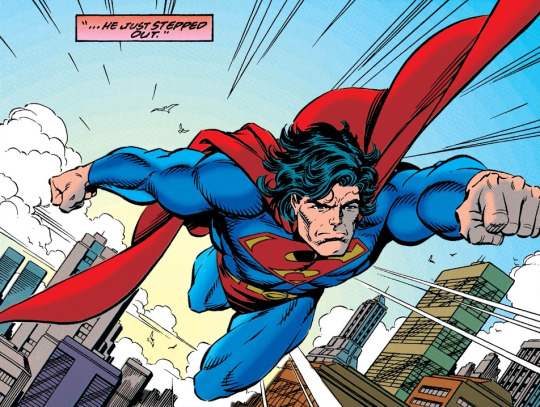
The sequence of Guardian acrobatically flipping from one ledge to another is very well drawn. Ditto the splash on page 13, where Superboy loses his temper. The body language in this whole sequence tells the story very well, as Superman is calm and patient, confident in his ability not only to reach Superboy with his words, but also withstand him physically.
The way Superboy snaps the carpet, but controls it mentally with his Tactile Telekinesis is a great example of his unique powers in use. It reminds me of a technique they tried on the CW Supergirl show (but almost immediately abandoned) where they made like the Kryptonian fabric of their capes was like “smart fabric” and could be used as a weapon.
Lastly, the dreamy, child-like expression on Superboy’s face during the Peter Pan exchange is wonderful, and a fitting end for Tom’s run on the book. [Max: You mean the William Shatner exchange, Don.]

STRAY OBSERVATIONS:
I almost never like it when they reference pop culture stuff in Superman comics, particularly music. Karl Kesel isn’t the worst offender in that department (that would be JM DeMatties a few years down the line, who had Clark Kent bizarrely asserting he loved the Beastie Boys) but Clark’s discussion with Jimmy about an apparently fictional musician working with a rolodex of early nineties names makes me cringe (as does trying to imagine how awful a “Hip Hop Lyle Lovett” or “Grunge Frank Sinatra” would sound).
The car poster on the wall of Jimmy’s bachelor pad looks for all the world like Robin’s Redbird, also a Tom Grummett creation. (Fun fact: Tom once told me he still gets {very small} royalty cheques from the Batman & Robin movie, because Robin’s motorcycle was called the Redbird, though that might no longer be true with Paul Levitz no longer in charge of such matters.)
Superboy (in no less than his third time calling those pink creatures “spuds”) references John Candy and Joe Flaherty’s “Farm Film Celebrity Blow Up” where the guests would frequently “blow up real good” and it does my SCTV loving Canadian heart good.
It’s interesting (and a little sad) that they again note that Superboy knows things (pop culture, etc) without ever having experienced it. I feel like there’s a lot they could do with this concept.
This issue reads very much like the end of the Superboy “Reign” issues, as Superman is more of a secondary character to the kid. All of it begs the question of why Superman, or Guardian put up with Cadmus. Superman has said in previous issues that he has moral problems with how Cadmus treats life with their cloning experiments, and they’ve attacked him in the past (and also stole his corpse!) so other than the fact that it’s a launchpad for Superboy’s series, there’s really no reason any of these heroes should associate with Cadmus. Especially Guardian, who comes off as little more than an errand boy here. He wants to bring Superboy in, but won’t promise Superboy won’t be harmed or imprisoned?
Nice to see Superboy return to his “Slammin’” catch phrase!
An interesting bit of foreshadowing when Superboy asks Big Words whose clone he is, and who immediately enters but Westfield. [Max: That’s right, Westfield! Not Luthor! Sorry, sorry.]
#superman#karl kesel#tom grummett#doug hazlewood#superboy#project cadmus#paul westfield#dubbilex#guardian#carl packard#rex leech#roxy leech#bloodthirst#bloodsport#hip-hop lyle lovett#grunge sinatra
26 notes
·
View notes
Text
My thoughts on #3 of Mega Man Fully Charged comic!
First, I love the cover, I was so happy when I saw Namagem when preview was released. Badass.
The #2 ended during a day, #3 begins during a day and next pages show it's the same day, I like the continuity.
We finally see Bert and Principal 100100!
By virtue of having the same programming, Namagem (I'm still getting used to Daini) can directly communicate with Aki - I theoretised that they may have a special channel for communication and I was not close, but this canonical information explains how Namagem was able to invade Aki's dreams in "" using Hypno Woman's power.
Abandoned infrastructure as a means to move around the city!
OH HI another theory of mine is correct?
Oh my heart, Namagem giving fuel to the starved robots, this is such a good character defining moment.
"That's the battlefield?" "No. You're standing on it." The art. That literal mountain of robot's corpses.
"the ultimate weapon"
Aki's reaction to the truth is heartbreaking. And Daini doesn't hide what happened but the way he touches Aki's shoulder shows that he tries to comfort him. wow. Daini seems disturbed be the truth too, but he had time to accept it and Night already caused him to think about himself as a weapon.
This is really a blow for Aki to find out about his role in the Hard Age NOT from his father. It's a small mercy that it's his brother that breaks it to him, as Daini also searched for the truth, but damn.
We've got confirmation that Namagem also existed during the Hard Age and fought alongside dr Light and Mega Man, they really were built at the same time. And I love this panel where all three of them are shown, although the context is so dark.
The question remains: Why Daini doesn't seem to have any memories of that time, only Aki?
"Who will you be? A hero for the humans? Or a weapon pointed in the right direction?" Daini warns Aki about the Skull Man's attack. I need to think about Daini's words to Aki for longer.
(Darn, I could make a separate post with scans of Daini expressions here, the last panel on this page, it's like he's half worried, half angry).
So, Aki makes his choice. I'm worried.
Suna is right, but given the state Aki is in, only
I understand that Suna' function is to be a voice of reason to Aki and she is right, but it starts to bother me why she has such a trust in dr Light. I mean he is her father, and it is good that she trusts him, but unless she has a reason, even a hand waved reason, this behaviour kind of suggest that she knows something she is not telling.
I feel that if she had a reason for this trust (and I mean in-universe reason, that the writers would at least acknowledge the fact that she seems to not be bothered by her fathers secrets concerning her brother) or if she was showed to chose to trust Light despite him being secretive it would make her character better, less one-dimensional.
Now Wily got creepy and megalomaniac. And uses Aki's care for Mini to convince him.
"You let your onboard counterpart perish" Emotional manipulation :(
Yes Aki, I've got questions about that face plate too.
Junkyard? Dismembered robot parts? Aki, 100% that Light does not wish to have such a lab.
<takes a closer look at the panel with wide shot of the lab> It's not just a face plate, there's a breast plate under it. Is this a foreshadowing?
"Protocol X" <looks at writers> So references to series X are going strong, both narratively and by dropping names.
The procedure looks both impressive and unsettling.
Undisclosed time later... And it's already tomorrow, Skull Man and his army are attacking the city.
Mini is back!
Okay... Skull Man and co attack Wily's home because Mega Man was there. Unless he had spies to inform him about Mega's location or other way to track him, how can we be sure it wasn't Wily who gave Aki out?
"Protect my life's work!" Priorities.
Wily leaves using a secret tunnel?
Blasto Woman: blasts through the wall. Skull Man, Chaotique and Guts Man: take the elevator XD That's a good joke.
Guts Man is born ready XD
I think I like Skull Man as the antagonist, I really hope he is not someone's puppet, he seems to honestly care about other robot masters.
Chaotique dearest, what is even you thought process? Why are you against Mega Man six months after "Panic in the Lighthouse"?
The composition of the panels and action is great.
Mega Man is overwhelmed, the suddenly!
ENTER ZERO! My reaction to a spoiler image with him was basically the Beyoncé??? meme.
He's got double energy blades, his helmet is obviously a callback to Breakman's/Protoman's helmet, but with his face is completely hidden... it reminds me of Vile.
Since he shows up in Wily's house and the descriptions of future issues state that a new ally will betray Mega Man... does it mean we gonna see evil Zero??
(I SO want to see a Mega Man & Namagem vs Zero fight!!!!)
Also: Chaotique in the background XD So angry XD
The issue 3 ends: The city is under attack and Zero (!!! who would have thought?) showed up! What's gonna happen next???
7 notes
·
View notes
Text
the itsv commentary is so full of great facts and bts info so i wanted to write down all my favorite parts, but i just ended up writing down anything that was interesting, which was honestly most of it. four thousand words later i ended up with their commentary on practically half the movie. i’ve put the interesting or funny bits that i jotted down behind a cut if anyone is interested.
this commentary audio had Phil Lord (co-writer, producer), Chris Miller (producer), Bob Persichetti (co-director), Peter Ramsay (co-director), Rodney Rothman (co-director, co-writer), but it was kind of difficult to tell who was talking most of the time, so i didn’t include names on who said what, unless I knew for certain who was talking.
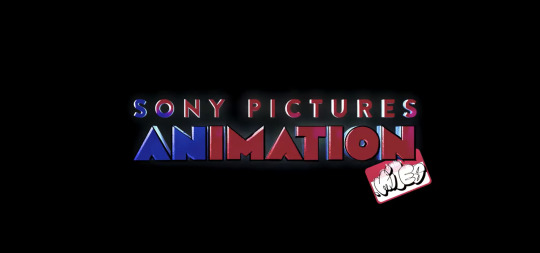
The first Miles sticker in the film is a “glitch” flashing on the Sony Pictures Animation logo. “Already putting his stamp on the movie.”

RIPeter is meant to be an amalgamation of all the Spider-Man we know, “good and bad” (as the dance happens, someone corrects him:) “Good and GREAT.”

(“I’ve got an excellent theme song, and a... so-so popsicle.”)
“That joke saved the movie.” “The dance move or the popsicle?” “The dance move. I resisted that dance joke and Rodney pushed hard for it (…) It told the audience what movie they were watching.”
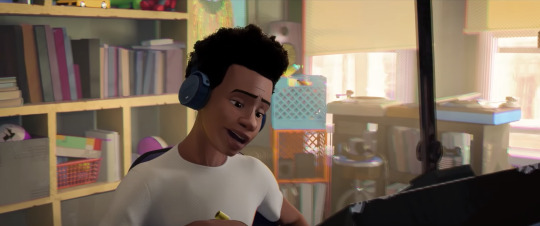
“It was Rodney who was really pushing for him to be in this relatable idea of [Miles] not knowing the lyrics to this song but singing along.” “We started animating before the song was finished. It was really easy to not know the words then.”

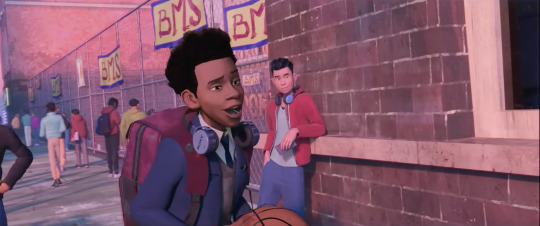

“There are three very long shots that introduce Miles.” (The shot at home, the shot of him walking past Brooklyn Middle, the shot of him entering Visions.) “That was a deliberate choice, to open with a big crazy Spider-Man montage, and then with Miles, start a different pace, long shots, and just watch him and how he is, and don’t get too fancy with it. Although ironically these shots are really fancy.” The shot of him walking past Brooklyn Middle and the one of him walking into Visions are meant to directly contradict each other: his comfort zone vs him out of place in new surroundings. (Megan’s note: My take is that with these shots they might have been trying to represent his home, his past, and his future.)
“Everything [in this scene from color to sound] is meant to go from a very heightened experience with Peter to a very naturalistic experience with Miles.”
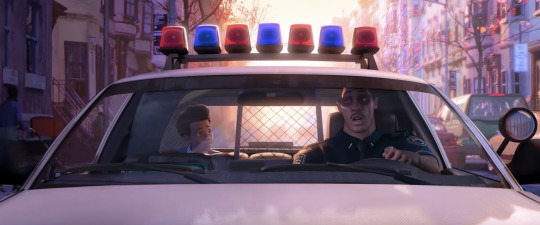
For the scene in the car, Shameik and Brian sat in chairs to set up in a car, with microphones and a rearview mirror. “Brian might have even been a little annoyed at Shameik a couple of times, and I think you can feel it in here, in a really wonderful way.”
(Talking about the chromatic aberration) “Sometimes it looks like you’re watching a 3D movie without the glasses on.” “That was on purpose.” “Every frame is supposed to feel like a piece of printed art.”
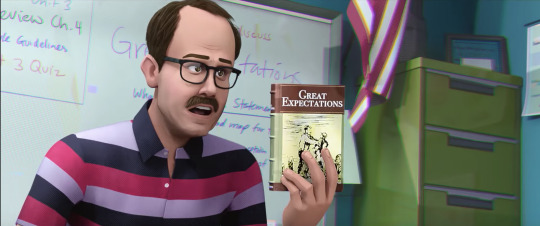
“On the cover of Great Expectations, there’s an image of Magwitch grabbing Pip’s shoulder in a cemetery.” “Foreshadowing!”
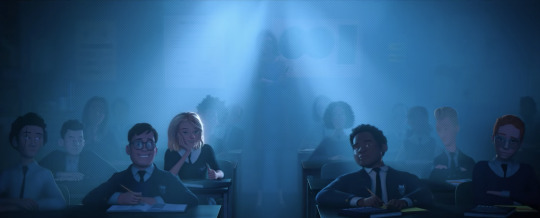
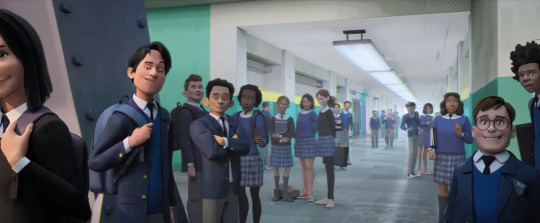
A side character named “Smiley Kid” is in several shots of miscellaneous Visions students. “Because he’s not a real person, I think we can say he is our least favorite person.” “I think he comes around. He’s great, then he’s bad, then he’s great again.” “He’s like the extra in every live action who worms his way to the front of every shot.” “He just almost always looks in the camera.”

Miles’s expression when the teacher calls him out at trying to fail was “completely ripped off of President Barack Obama.”

Benson Avenue was meant to call back to where one of their fathers grew up in Bensonhurst, Brooklyn.
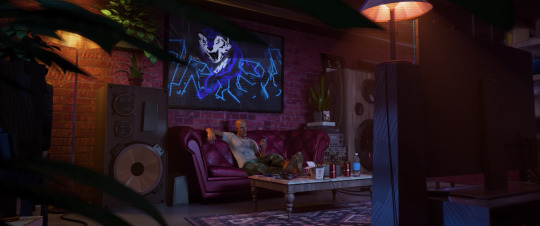
(“Hypnotize” by Notorious BIG playing on Aaron’s stereo) “Biggie Smalls in an animated Spider-Man movie. In what universe?” “This is the ideal timeline that we’re living in.”
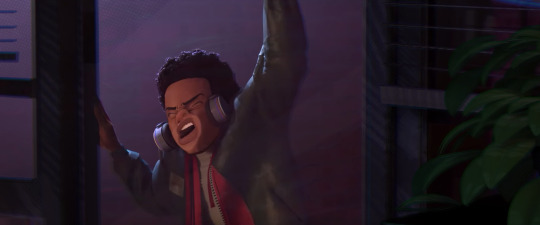
(This comment is said as Miles presses his face on the glass:) “That changed people’s perceptions of the movie. When we had this in, it really lit people up.” (To be honest, I can’t tell if this comment was made in response to Biggie Smalls, or to Miles pressing his face on the glass.)
They all loved Mahershala Ali. “The shoulder touch would work if your voice sounded like Mahershala’s.” Everyone was in awe every time they recorded with him. “He makes you want to be a better person when you’re around him.” “He’s got a high bar.” “Then he goes away and it kinda wears off.”

The subway Aaron brings Miles to was a place he and Jeff used to paint in when they were young, which adds another layer to him talking about/missing Jeff when he mentions it to Miles. The age difference probably means Aaron was younger than Jeff, and now he’s the older one with Miles here.
There’s a bigger history between Jeff and Aaron that’s only hinted at, and part of it is the reason why Miles has his mother’s last name, not his father’s. It’s implied Jeff was worried his bad history would follow Miles if he took his last name. Also because “then he would be named Miles Davis.”

They were excited to depict a spider-man experiencing spider-sense for the first time.
“We did the most expensive thing. In all choices.”
“People ask, How does Miles with a cop and nurse parents afford Jordans? And the answer is, they were a gift from his uncle.”

(On Kingpin’s animation possibilities.) “We always had this idea that he was the living expression of a black hole. The right for him is this floating head on a body that we could scale up and down depending on the shot with hands at the end of arms.” “While creating a black hole, he is a black hole.”

Someone felt very passionate about including the dimensional map showing the other universes the collider was connecting with. “It felt so important to me.”
(Paraphrasing this one) “Once Phil and Lord gave the MO to push convention, the gauntlet had been thrown, we started getting crazy stuff back. And a lot of the time our art direction would just be like, ‘Yeah! COOL!' ‘Do more of that!’”

(Peter rolls his eyes as the Prowler menacingly steps forward) “I like that [RIPeter] is exhausted at the idea of being killed.”
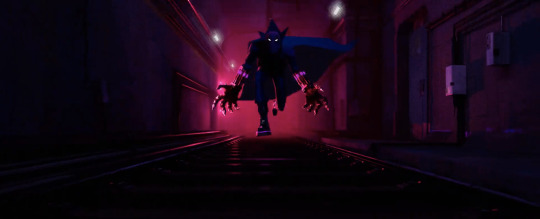
“The Prowler chase sequence was the first sequence that went through the whole pipeline.” (This and the cemetery scene were the first.)

(The burst card of Miles jumping over the subway tracks) Bob Persichetti: “I had such high hopes to do a lot of burst cards, I think that’s the only one I actually did.”

(as Rio comforts Miles in Spanish) “We never translated on screen (…) The idea being, this is the fabric of Miles’s life.” “This was inspired obviously by Brian Michael Bendis” (co-creator of Miles Morales and his longtime writer) “and Miles’ bicultural background. But also Phil Lord grew up in a bilingual house.” “And I took Spanish in high school.”
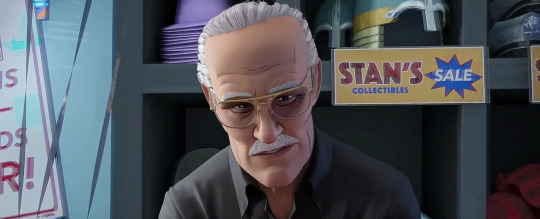
(Stan Lee cameo) “[Stan is] the only performer in the movie who we went to. Everyone else came into recording studios, but Stan Lee, we dispatched the microphone to him.” “Everybody wanted to animate Stan.” “If you hit pause any time a train goes by, because everyone wanted to animate Stan, he’s in almost every single train.” “He’s an extra in a lot.”
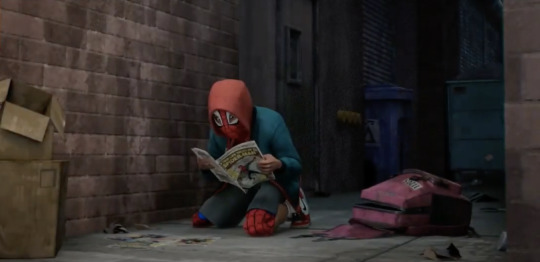
(Miles reading comics before jumping off the building) “If you notice in that comic book, it’s True Life Tales of Spider-Man, and to keep his cover, his name is not Peter Parker. In the comic book, his name is Billy Barker.” “Great.” “Who could ever figure that out, right?”

A bunch of drawings around the grave of Peter Parker’s tombstone were all done by different kids of people on the show.
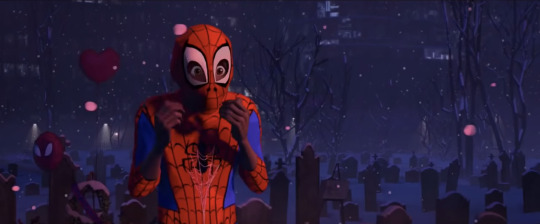
They mention the cemetery scenes was one of the first ones finalized. When they were still trying to figure out how to bring Miles to life, “you can see that his performance evolved from this [cemetery] scene.” “It’s super expressive.”
There was lots of debate on how much paunch should be on Peter B’s stomach. There are something like 3-5 different body models used throughout the movie.
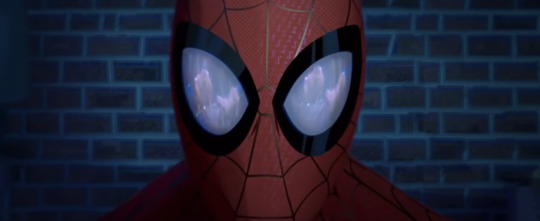
They all loved the scenes of Peter B in his apartment: the cut to him crying in the shower, to pinned to the bed with his butt out, to his pose on the futon flipping through channels. Someone really liked “[his] little quivering [spidey] eyes on the seahorse shot.”

The comic book page-flipping device was a “late breaking” realization of how to transition between flashbacks and present day.
Chris Miller did the voice of the cop dispatcher on the radio saying the “Child dressed like Spider-Man dragging a homeless corpse behind a train” line. “The role I was born to play.”
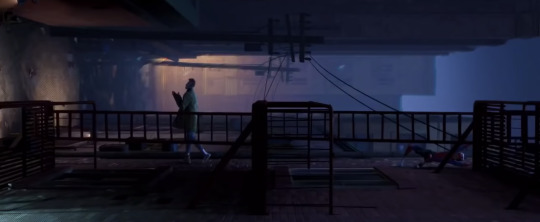
In the walk-and-talk scene in the alley, they felt inspired to take a lot of crazy shots. “We were passionate that a Spider-Man movie needed to be shot from their point of view, where every surface can be the ground.”
“Because of questions on the internet, we took of one of Miles’s shoes. Just in case anybody wanted to know why he was sticking.” “Another thing that I was passionate about but nobody cared about but me.”

“One of the big tricks of this sequence and of this relationship was to let you believe that Peter was a good guy even though he was being a real… turkey… to Miles.” (Peter saying “No, does it look like it’s working? No! No, it’s not…”) “This was one of the few moments that we added kind of late just to know that he was a sweet pea underneath it all.” “Finding the right level for his not caring about Miles, and then learning to care about Miles, finding the right level from the beginning all the way through to the end, was something that took a lot of nuance.”
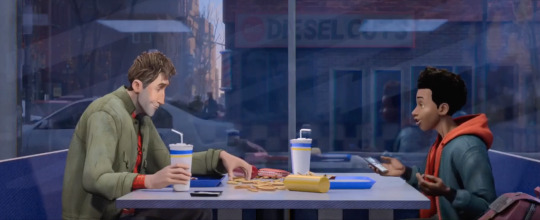
The interrogation/alley and burger scenes probably went through the most amount of reworks and rewriting than any others, because there was so much exposition and “you got tired” watching two heavy information scenes in a row. And given how often they said “this scene went through so many iterations” in this commentary, these two scenes must have been a LOT of rewrites. (Some of the alternate burger scenes can be seen in the film’s trailers and alternate universe cut.)
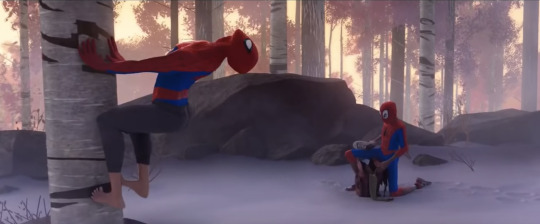
“I still kind of miss the unfinished version of this shot, where his feet… He had no toes for a really long time for some reason.” “You had to say like fifty times, ‘We’re gonna add toes right?’” “‘We’re gonna get his toes on there, right?’”

“One of the things about Kingpin is that he just magically appears outside of the car. Because there’s no way he could get actually get through the doorway.” “Maybe in the future where you guys are watching this ten years from now, someone will have figured out how to animate that. But in 2018 it’s still impossible.”
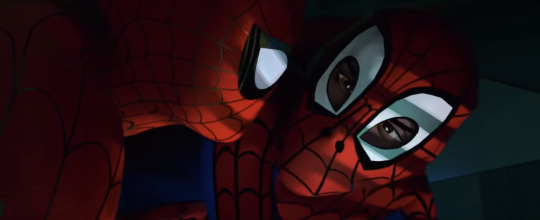
(Miles finding Peter in the vents) “These moments were really when you started to feel the relationship between the two of them develop.” “I love that Miles has to fight to occupy the same space and become an equal to Peter.”
(Peter mockingly blah-blahing as Doc Ock explains the danger of the collider, then saying afterward “Oh nevermind, that is bad.”) “For the sake of a laugh, we undercut the stakes, and then immediately had to buy the stakes back.”

“We went through probably 70 different version of what Miles would look like while invisible … and I like how how he comes in and out of invisibility was stylized to some degree.”
They say the Doc Ock/Peter scene was “really really bad at one point” and now it’s “one of the most wonderful surprises.”
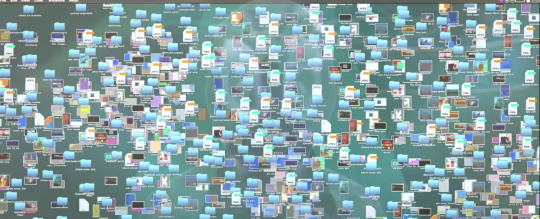
Ock’s computer is based off of Phil Lord’s actual desktop. Some files are cut off the edges of the screen because they just dragged things off of the internet.
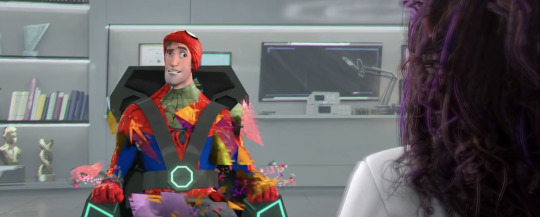
(Peter glitching in the chair) “I’m remembering all of the conversations that determined that it was funniest if you left Peter’s head unglitched.”
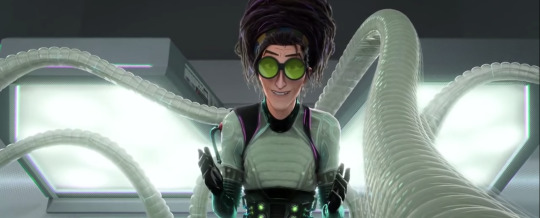
It was Justin Thompson’s idea to use soft robotics for this version of Dock Ock’s tentacles.
Everyone, from animation to the sound team, saw Doc Ock’s tentacles about 3 months before completion, went (exasperated) “Oh THAT’S what they look like? We’ll have to redo X Y Z whole thing…”
You can tell they loved the monitor joke. “Very silly things happening around very cool things.”

The Bagel! text was added last minute. “That was a joke pitch by Justin that was taken seriously.”
“Everyone felt empowered to pitch crazy ideas, and that’s why it felt so rich and deep.”

“It’s no understatement to say that this look in the forest is one of the hardest things in a movie like this. To make something look realistic is something we know how to do pretty well. But to make it look graphic and illustrative is almost impossible.” “Especially when you’re close and far to trees within the same shot at times.” “We had so many conversations with Danny, our V Effects supervisor, like, ‘But, you guys, we’re going to be in a forest, you really don’t want the leaves to rustle in the wind?' ‘No, we’ll be okay!’” (Later, when Peter and Miles swing off together, the leaves rustle:) “See, the leaves can move, guys!” “We just CHOSE for them not to.” “It was an absolute creative choice.”
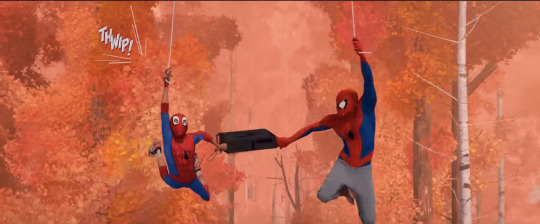
“This is another moment in the story when we really open this beat up to let Peter and Miles have a victory together and cement their bond, that you really were rooting for their relationship. We breezed through this quickly and you didn’t have the same connection with the two of them.” “One of the things in the screenplay that we discovered really late is that you needed to have a lot of smaller, positive accomplishments throughout the center of the movie to have it work right.” “(…) This middle section of the movie is about Peter and Miles learning to fall for each other, basically.”
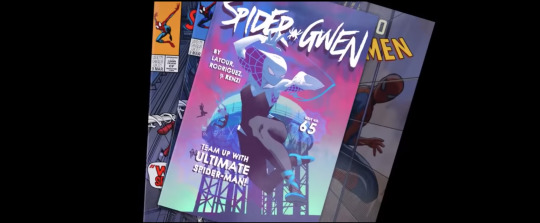
(During Gwen’s intro) “We give just enough to hopefully tease you guys into being really into each one of these characters’ origin story.”



“One week of days and nights just passed in that one shot.” “She hit a time anomaly on her way to this dimension.”
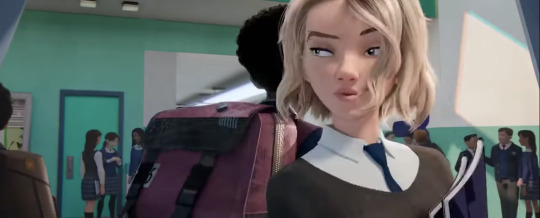
“She vibes with Miles after he had been bitten by the spider, and she purposefully bumped into him there, in case you didn’t catch that.”
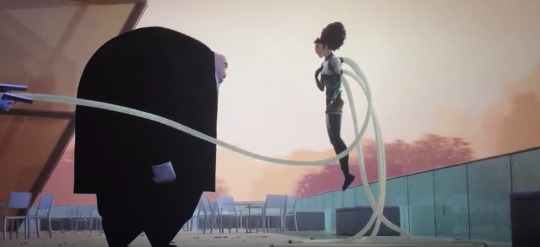
“We were trying to make Ock such an intelligent and socially awkward person that then turns into this really formidable equal to Kingpin.”
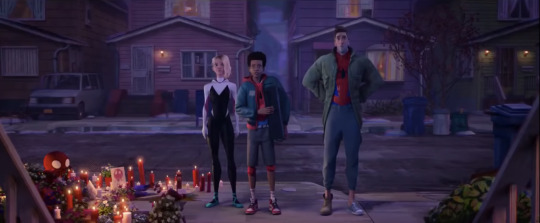
(When Peter thwips May’s doorbell and then exhales with his hands on his hips.) “One of my favorite poses in the movie.” “That pose gets a laugh all by itself.”
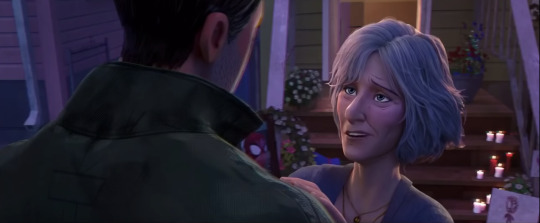
“‘You look tired’ is a thing my mom says to me every time I see her.” “It’s accurate.”

“I fought hard to have (May) kick that door open.” “I tried to cut that and then you uncut it, correctly.” “Let’s be honest, she’s not treating her house very well.”
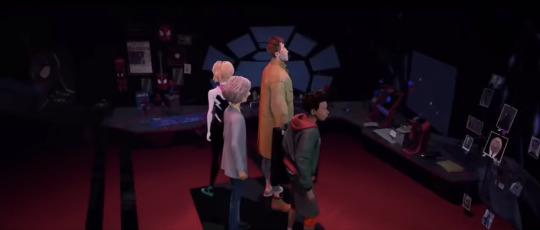
(In the Spidey Lair) “Lots of Easter eggs here.” “We should’ve put an actual Easter egg in this shot.”
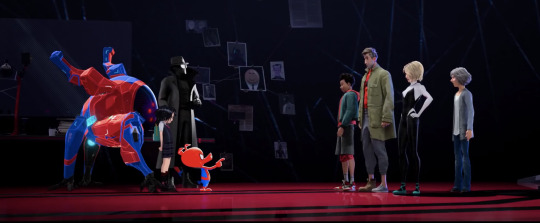
They debated for a long time putting the B-team spiders in the picture at all, knowing it would be more work, wanting to make their characters worth being in the picture without taking away from Miles. “Nothing worked in the movie until it had something to do with Miles and his story.”

(On the spider team testing Miles:) This angle was “late-breaking, on the backside”: “This made it feel like they all cared about Miles, even though they maybe didn’t believe in him.” “Just Peter going ‘Cool it.’ For the longest time we didn’t have something like that.”
(Pretty sure this is Peter Ramsay) “When you’re making a movie it’s like you’re building an emotion machine. You’ve gotta have all the parts calibrated the right way, make sure it’s properly oiled, cause if it isn’t, the gears are gonna stick, and you’re not gonna feel right.”
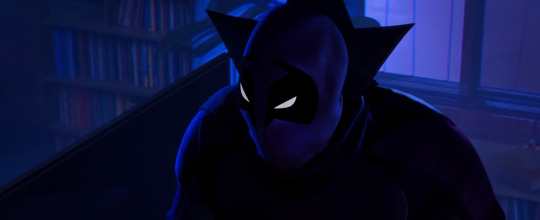
The Prowler Sound™ is not a jaguar or cat, but an elephant. “We only did the dark scenes first cause they were easier to light.” (Some of those scenes they mention are Miles running from the Prowler, the cemetery scene, Miles writing the note in Aaron’s apartment.)

They tried about a million songs for Peni while she makes a new goober. (The song used is not in the soundtrack, but it’s “Want It Here” by Xenia Pax.)
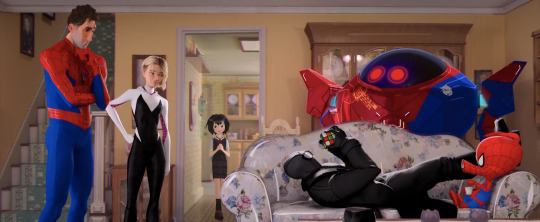
(On Peni’s Heelies) “This shot’s not long enough to get her from the kitchen to the couch.” “Is that why?!” “That’s one hundred percent why. Just put those little wheelies on here!”
In the first draft, there was an idea there RIPeter was a grad student under tutelage of male Doc Ock so that’s how Liv and Ock knew each other.


“The table pushing into Miles. That was something my older brother, when we would fight when we were kids, he would do that to me.”

(When Aaron closes his eyes, refusing to kill Miles:) “That little look. ‘Cause he knows what’s coming.”
(They’re all quiet as Miles carries Aaron to safety, caught up in the scene.) “We’re all kind of gripped.” “We’re supposed to be giving interesting anecdotes here, guys, come on.” “It was so cold that day…”

Prowler’s death was the first session they did with Mahershala. “He’s a method actor, and his death scene, it was like he was really dying.”
“We gave animators the freedom. You can make Miles unattractive. He can ugly cry, because this is raw and it feels so emotional.”
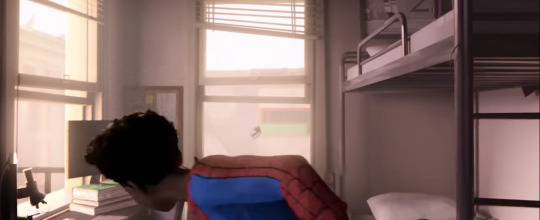
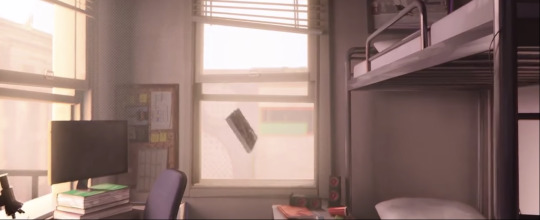
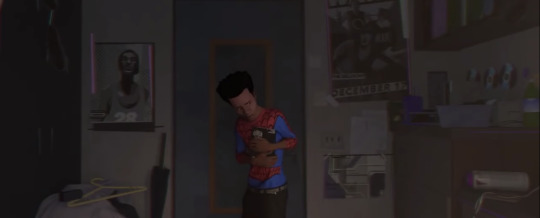
(When Miles throws his sketchbook out the window, only for it to immediately come flying back in:) “It’s a one-shot transition from deep emotion and regret and pain. We said, ‘He’s gonna throw the one thing out that really represents his uncle, yet it’s gonna come flying back in.’ It was hard to make that shot work.” “It’s a great story statement that you can’t lose the things that make up your past.”
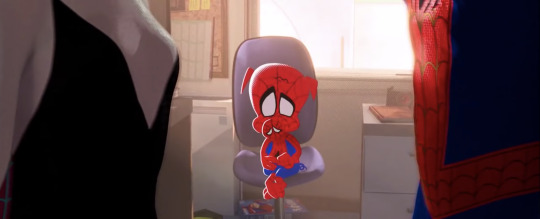
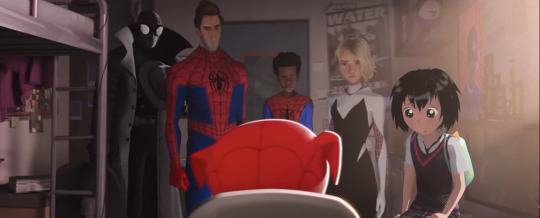
When everyone is talking about someone they’ve lost, an alternate line has Ham saying “I lost my uncle. He was electrocuted, and it smelled so good.” It got a lot of laughs, but the team says that from then on, the audience “resisted” Ham because he killed the mood, and it was hard for people to see him as anything other than a goofy cartoon, so they changed the line to “Miles, the hardest part about this job is you can’t always save everyone.” (Megan’s note: I think they probably didn’t bother to re-animate the others’ facial reactions after changing Ham’s line, because judging by the reactions from Peter and Miles in this shot it feels like Ham just said something annoying/out of place lol.)
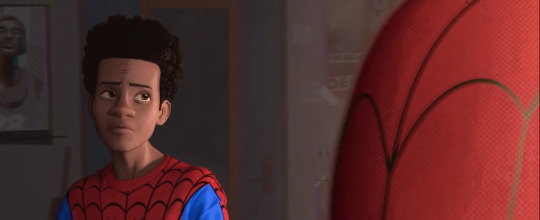
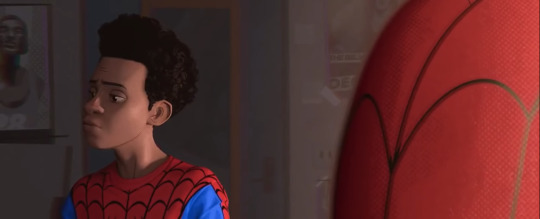
When Peter says “It wasn’t their decision” (for Miles to stay behind), Miles has a very quick reaction shot where he turns away, bites his lip, and shakes his head. Someone mentions it’s one of their favorite shots of Miles.
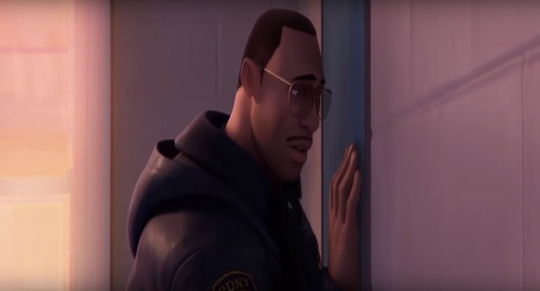
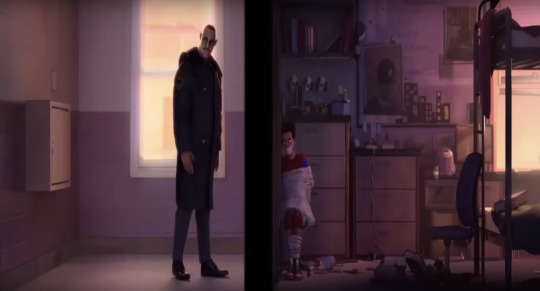
(On the scene with Miles and his dad at the door) “When Brian Tyree Henry saw this scene [with a rough performance, just animation], he got the movie. It made such an impression on him. He was very happy to come in and pick any lines up for us and just keep working.” “We were working on the shots on layup for this. The idea of having them be on thirds to start, then coming closer, and finally ending with the final split-screen shot at the end.” “And Jefferson crosses the scene, which I think is really interesting. They start off on opposite sides of the screen. He makes the first move.” “It’s amazing to me to see Miles transformed by his father.” “It feels earned.”
“In an earlier version of that scene, Aunt May gave him a version of that speech, which was nice, but it needed to be Dad.”
(Later on, someone mentions:) “Tom was the first one to say ‘It shouldn’t be Aunt May at the door, it should be Dad.’ And we all sort of slapped our foreheads going ‘That’s absolutely right.’”
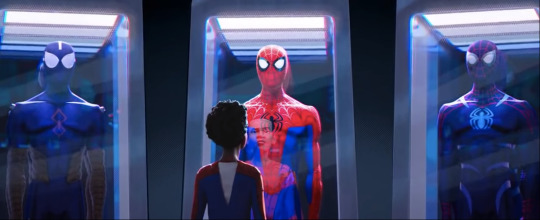
“After our premiere, my 9yo son [Luca? Luka?] asked me this. ‘So Papa, you know Miles spray-paints one of those suits and it becomes his suit. Super cool, Papa, but it shouldn’t fit him. It’s way bigger.’” (Laughter) “Did he have to wait a few hours for it to dry?” "We cut out the sequence where Aunt May sewed it tighter and altered it.” “And they had the hair-dryer express drying it. ‘Your friends are in danger.’ ‘Well just let me let it dry first!” “I tell you, spray paint, five minutes and you’re dry.” “She pre-altered it. She knew he was coming. She said, ‘It took you long enough.’ It all happened in advance.”

“The scene of Miles falling and everything slowing down and I always appreciated that Phil called out he was ‘falling and rising’ and the same time.” “It made the movie. A rare thing that goes from the stage directions all the way through production and onto the screen.”

“This sequence used to end with him getting hit by a truck. But really felt like it was time for Miles to get a big victory.” (Megan’s note: This scene is shown in draft stage in the alternate universe cut. Miles makes his leap, free-runs over some trucks and buildings, and his scene is interrupted when he gets hit by a truck and crashes to the ground. There’s a moment where he collects himself, the pushes himself to his feet and runs off into the city to join the others at the collider. I interpret this idea to be their showing how Miles fully embraces the “Get back up” lesson, since Miles’s pose in the sketches imitates the same one in the basement when the spiders are hazing him and he’s on the ground.) “And now people applaud.” “There’s a general attitude with this movie that was like, ‘How can we do things differently?’ That was a case of when we were like, ‘What if we didn’t have the audience feel really good in this moment?” (Laughter) “What if we had them feel really bad? Right at the moment they want to feel good, what if we made them feel terrible?” (Joking) “Let’s poke THEM in the eye.” “I think in early drafts, we just were like, Miles is losing and falling short the whole movie until the very end. And when we put that up, we realized that you needed to see him slowly winning and winning and winning until he won even bigger at the end.”
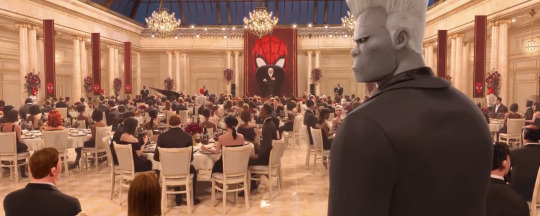
A set-up that never fully made it in the movie is that Fisk runs charities for Spider-Man and that’s why the dinner was set up like it was.
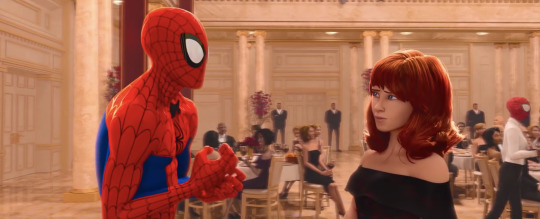
The bread scene was on the chopping block for a long time. “By adding this interaction, and making it about Peter and MJ and something real, all of a sudden this scene was worth it.” “It’s necessary to know what Peter’s giving up by sacrificing himself.” “It lasts just long enough because we learned that if you stay way from Miles too long--” (They interrupt here to point out two cameo people at dinner, “Danny and Josh,” who I couldn’t get a cap of) “--We lose our connection to the movie in a way. But at this point we care enough about Peter to want him to get back to MJ too.”
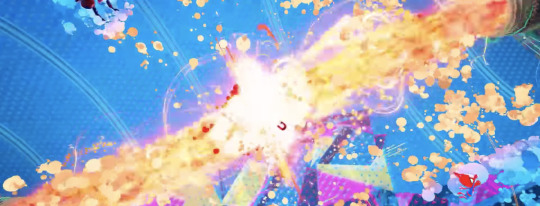
“The servers that were holding the movie were moving slow by the end of this shoot. And we had the best computers.” “At a certain point I think we overloaded Imageworks’ server. There was a moment they were afraid the movie was going to break their machine.” “Which was our whole idea. Our whole approach was, how do we break these pipes that make the movie?”

(During the final collider fight sequence, but they don’t specify what idea this was about specifically:) Chris Miller: “One of the only times I can ever remember saying ‘Okay you’ve gone too far.’ There was one brand where I was like, ‘I don’t get this.’ A few of the drawings that were somehow even more insane than this.” “What you’re saying, Chris, is that there’s a version of this scene that’s even crazier than this?” “Literally the only time I can remember going, ‘Okay guys, you’ve done it. You’ve broken it.’”
“I’m sure there’s are filmmakers watching this, so I think this is a learnable lesson from this sequence. Which is if you want to put something super crazy in your movie, wait until the very end when a lot of movie has been spent on your movie and your release date is 3 to 4 months away and they literally cannot stop you or else they have no movie.”

One of them points out Miles webs a turntable to propel himself upward. (Megan’s note: Miles also does this just as his own theme starts playing, which starts off with a record-scratch. I thought that was cool.)
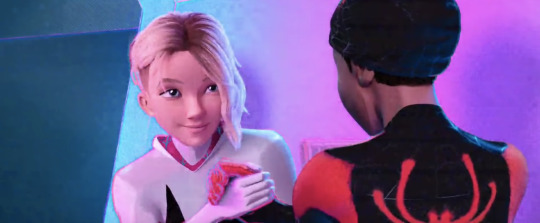
(The moment when Gwen calls Miles “Spider-Man”:) “That choice went through a lot of iterations like “What’s the end of their relationship?” That she calls him Spider-Man instead of giving him a kiss on the cheek? It makes me well up just thinking about it.”
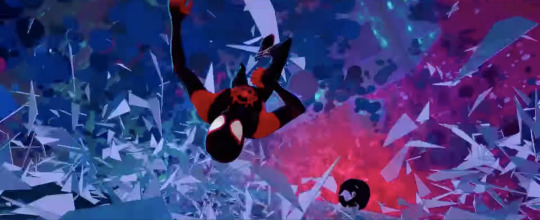
Kingpin breaks the glass of a building and the pieces fly toward Miles. Bob Persichetti calls these “Dorito chips.”
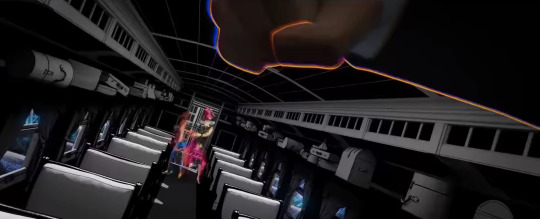

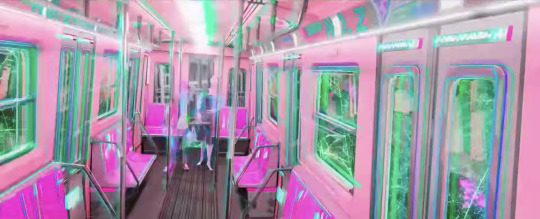
After the train enters a collider steam, there are versions of the interior of the train that flash from all five dimensions. There’s a futuristic Peni version, an old-timey Noir version, there’s a Gwen version… “As it passes through the beam, you get to see five versions of the train existing at once.”
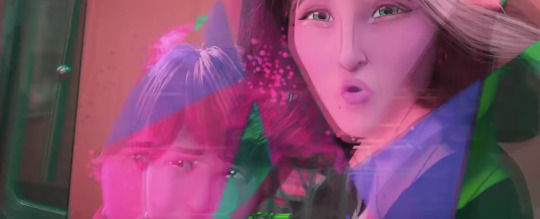
(Vanessa and Richard seeing Kingpin) “This idea of repeating mistakes (for Kingpin). No matter what, he was gong to keep repeating these mistakes.” “He’s still who he is.”

“It was my dream to have Kingpin headbutt Miles and it finally came true.”

Each one of these character is in a black costume, and black surrounds them, and yet you can still see what’s happening.

“I remember people wanting to cut the shoulder-touch at the end.” “Who wanted to cut this?!” (Overlapping chatter) “No names in the screen.” “I remember feeling, oh my god. You’re LUCKY you got the shoulder touch in.” “The fact that you could pay off a set up that wasn’t even a set up…”
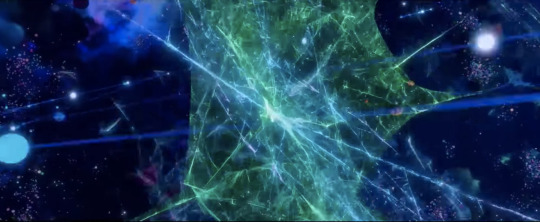
(On Miles seeing inside the universe as the collider explodes) “And then this. How long can it be? Let’s make it way too long!”

“The Anvil (that clanks at the end) was in Ham’s pocket?” “In the hammer space.”

(Miles hugs Jefferson) “This was the moment everybody went ‘Oh, YES.’ No matter what, we have to get to the hug, and the disguised voice, and the ‘I love you.’”
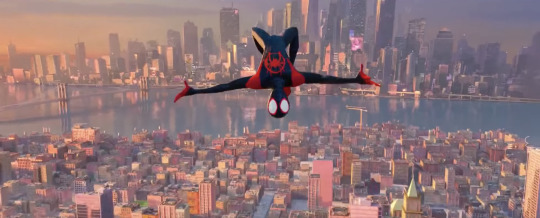
Someone describes the ending soundtrack as “Miles’ playlist meets Aaron’s playlist meets a superhero movie.”
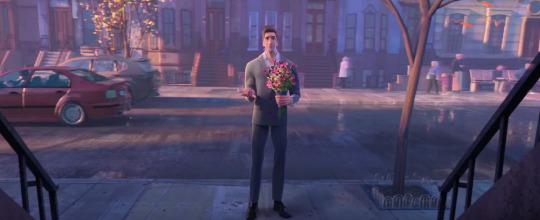
They indirectly confirm Peter B and MJ do get back together. “Peter B gets his happy ending.” Another bit someone mentions was a late addition.

“I like that the movie starts and ends with Miles in his bedroom by himself.”
“We could do a whole other commentary saying completely different things.” “Probably four.” “We should do an alternate universe commentary.”
“You’re your own champion, I think that’s the idea. This is a story of empowerment. A champion is not coming from outside of you to come and save you. It’s your job.”
(As the credits roll) “Every name you see right now, we’ve seen them cry.” “We’ve made them cry.” “Every name you see right now has yelled at us.”
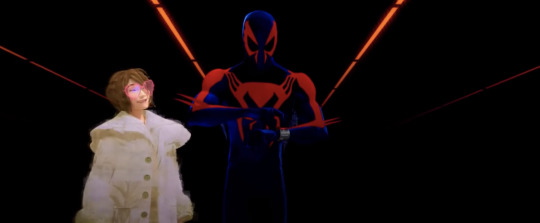
(On the post-credits scene) “We thought of this (post-credits scene) two months ago.” (They recorded this commentary in Dec 2018.) “We wanted to get Miguel in there and show the opportunities of where the multiverse could go.”
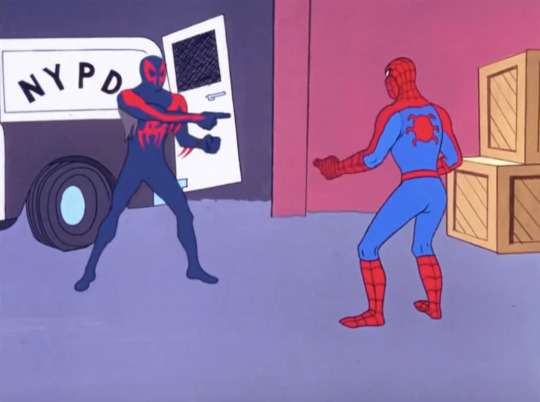
“I looked this up. This IS the most expensive dumb joke of all time.”
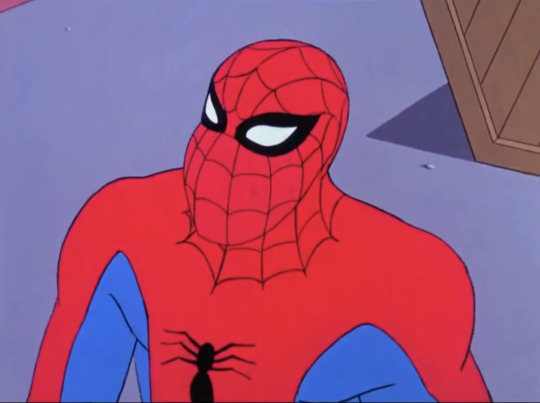
“We didn’t finish cleaning the cell on that close-up of Spider-Man.”
29 notes
·
View notes
Text
February 18th-February 24th, 2019 CTP Archive
The archive for the Comic Tea Party week long chat that occurred from February 18th, 2019 to February 24th, 2019. The chat focused on Patchwork and Lace by Sooz.

Featured Comment:

Chat:
RebelVampire
COMIC TEA PARTY- WEEK LONG BOOK CLUB START!
Hello and welcome everyone to Comic Tea Party’s Week Long Book Club~! This week we’ll be focusing on Patchwork and Lace by Sooz~! (http://www.patchworkandlace.com/)
You are free to read and comment about the comic all week at your own pace, so stop on by whenever it suits your schedule! Remember, though, that while we allow constructive criticism, our focus is to have fun and appreciate the comic. Below you will find four questions to get you started on the discussion. However, a new question will be posted and pinned everyday (between 12:01AM and 6AM PST), so keep checking back for more! You have until February 24th to tell us all your wonderful thoughts! With that established, let’s get going on the reading and the chatting!
QUESTION 1. What has been your favorite scene in the comic so far? What specifically did you like about it?
QUESTION 2. At the moment, who is your favorite character? What about that character earns them this favor?
QUESTION 3. What has been your favorite moment between Sheol and Lilika? What about their relationship dynamic stood out to you? Ultimately, do you believe the two will wind up together romantically, or will the past keep them apart?
QUESTION 4. In regards to Sheol’s PTSD, what moment most stood out to you? Do you believe Sheol will be able to heal, and if so, what will it take? How might Sheol’s continued suffering affect the story or her relationship with Lilika further?
Delphina
I really like the scene with both Sheol and Lilika's flashbacks happening simultaneously. Something like that could have been very confusing, but it was laid out really well with the chain going down the middle. http://www.patchworkandlace.com/?p=451
Lilika's probably my favorite of the two main characters. She's sort of like this adorable dark demon-summoning cultist Card Captor Sakura. Darray is pretty new, but he also cracks me up.
Delphina
Lilika and Sheol's dynamic is interesting and falls a lot on hurt/comfort patterns. The kiss (http://www.patchworkandlace.com/?p=533) was satisfying, both as shipper kerosene and also because it was one of the few times that Sheol expressed something she wanted instead of just protecting Lilika or doing her duties. Even if it's not romantic, I hope there's more situations like that in Sheol's future where she discovers who she is and what she wants in (un)life, but I suspect that there's still going to be a lot of secrets she'll keep from Lilika before she really gets to a place of balance and peace. I suspect Lilika and Sheol will end up together, but only once Sheol is able to let go of the pain in her past and stop protecting Lilika from her secrets.
€heshire777
Sheol looks a lot like Unity from skin horse.
Stefan G
1) There are so many beautiful scenes, but my favourite one so far was this one ... I think the interaction/dynamic between the characters works really well/naturally and the ending made me chuckle. I enjoy humor like that
RebelVampire
QUESTION 5. Who or what do you think Lilika is a vessel for? Why was Lilika specifically chosen for the role and why do you think they can’t just find a replacement?
RebelVampire
@Stefan G For future record, it's better to link the page by URL rather than post a screenshot. Many creators don't like screenshots of their work taken, and images also aren't included in the archive either. Thus, to readers to the archive, your comment would actually have no context.
Stefan G
Roger that
...this is so difficult
Delphina
It definitely seemed like Lilika was special and advanced in magic for her age. I'm just curious all around about the organization (cult?) she grew up in and what their motives are. It definitely appears that whatever they originally wanted for Lilika, she's a free agent now who's doing pretty much whatever she wants, so I would assume she got too powerful for them to control and ran away. So if they don't even have anybody on her power level because she's over 9000, it makes sense that they want to get her back.
RebelVampire
QUESTION 6. How exactly do you interpret Sheol’s past so far as it’s been shown? Who do you think her former master was? In the end, how do you think Sheol came to be on her own and will her former master come looking for her?
RebelVampire
1) i really liked the most recent scene where sheol is talking about leaving lilika while you can hear lilika just teaching the kiddo in the bg. before i felt their relationship was just kind of set in stone (romantic or not) in terms of them staying together. but this scene...this scene added doubt. now theyre not just star crossed lovers, but actually have to work at the relationship, whatever their relationship is meant to become. and i really like when stories add a complicated aspect like that, because relationships are work whether theyre friendships or something else. 2) Lilika. I just like this dynamic of Lilika being cutesy but summoning the most horrific looking creatures. Yet, even if the creatures are weird looking, she shows them a lot of kindness in a way. I also like shes more of a hiding her cards type of character. While I like Sheol, her emotional issues are pretty in your face so you can basically see her deck of cards. Lilika though? I don't know how she might be hurt or traumatized and I like that a bit more. Adds more mystery to solve. 3) I liked the scene where Lilika is offering understanding and comfort to Sheol being out of sorts. Just...it was such a positive interaction and really showed the depth of Lilika's care for Sheol beyond just having a bunch of shirts handy. I like in general how the two of them are somewhat opposite in personalities and yet have this subtle way of getting along and showing their care. As for the ship, I'm gonna be optimistic and say yes. And assume they won't go up in flames.
varethane
that answer to 2 is really interesting, because in that respect they're both kinda opposite to the usual tropes that tend to apply (the stoic/stern type vs the bubbly, upbeat type)
you'd expect that Lilika would wear her emotions and background on her sleeve while Sheol would keep everything close to the chest, but it's the reverse, haha
Delphina
Yeah, to get a bit meta about it, the webcomic title is a pretty obvious reference to the two main characters, so I think they gotta stay together.
varethane
I hadn't thought of it that way til I saw your reponse though
RebelVampire
4) The moment where Lilika asks if Sheol is good but Sheol was like, "no but ill manage." That was such a sad slap in the face but so true to trauma. Cause sadly life doesnt care if you are traumatized. Sometimes you have to go live life and just manage. And I liked seeing that in the story cause it made the trauma more relateable to me. As for healing? yes, but years and years and years and years from the current time. For now though, I think Sheol's trauma is actually gonna get in the way and stop her from helping Lilika when Lilika most needs her. Then drama and conflict ensues. 5) Probably this comic's version of cthulu. As for why specifically Lilika, like Delphina I assume magical talent. But I'm skeptical at the time cause if all it took was magical talent, they wouldnt need to chase her down. Just get a new student. So I feel there must be super special about Lilika's talent. Like she has some sort of connection even better students don't have. 6) I assume her master was some lord scientist who just felt like playing god. And that he was using Sheol to both prove his awesome and gather some sort of resource. Hence the whole targets thing. I personally think that Sheol just ran away cause she found some body part had murdered a shiz ton of people and could no longer live with herself of the selves she was made of. It sounded like he was alive, so I do think her former master is gonna come looking for her? Or someone close to him. I mean not everyday you hear about living flesh dolls, so someone is bound to be interested.
huh, you make a good point @varethane . actually had not considered that their types are different from the expected trope
Delphina
On the topic of Sheol's past, it looks like Zerymos assembled her. Nell and Lilika's cult seem to know of him from the recent pages, so I assume the dude is either a cult-adjacent individual practitioner or split off to do his own thing. From the flashbacks, Zerymos pretty much made Sheol go out and murder specific people on the regular. (From this scene http://www.patchworkandlace.com/?p=452 and the one that I can't find where the person recognized her mouth and wanted to "kiss their daughter" one last time - (Really wish this comic had an archive page...)) I first suspected Zerymos wanted corpses for more experiments, but in the first scene, she's not carrying the body back, so maybe he's a leader who just wanted to freak people out and flex his power over them? He certainly didn't seem to be worried about Sheol using discretion since she just walks into a crowded group of screaming people and chokes 'em. If she's been that overt and people have heard of her, then it definitely makes sense that she wants to cover up as many scars as she can, but I've also been curious why she's only covering the mouth because you can still see the stitchwork down the middle?
varethane
she's still gotta see lol
that's why the broad-brimmed hat I guess, it puts shade on the area she can't help but keep exposed (unless she invests in something like this )
Delphina
Maybe the big hat helps, but yeah, I'd get me a ski mask or veil or something if I'd been that murdery.
snuffysam
she could go all invisible man-style with bandages and a pair of sunglasses
and yeah if Zerymos wanted stealthy kills, he probably wouldn't have made her walk around naked
RebelVampire
QUESTION 7. Do you believe that Nell will succeed and capture Lilika? If so, what will happen to Lilika? What will Sheol do? If not, how will Lilika and Sheol manage to avoid capture? How will it affect their future plans?
RebelVampire
7) Nah. I honestly think Nell is going to vastly overestimate her skills and vastly underestimate Lilika. It's also 2 v 1 right now since her partner was sent off, so nell probably isnt gonna have a good time. Sheol, assuming she's present, will over course protect Lilika. Although this begs the question of how much of Lilika's past does Sheol know? I mean of course she knows of Lilika's demony magic stuff, but did Lilika mention anything else? cause if not, that's the point i feel Sheol is gonna go wtf and want answers. but yeah i think after all is said and done, theyre gonna skip town for a while together.
Delphina
Well, it seems like Nell is going to be forced into seducing Lilika away for reasons I don't quite understand (http://www.patchworkandlace.com/?p=589). So I suspect it's not going to be a physical fight (which I agree, Lilika and Sheol have the advantage with, especially if Lilika is irreplaceably powerful and Sheol has no visible physical weaknesses) but a love-triangly-psychological sort of approach. Drive doubts in both of their heads about whether they really love/trust each other so they're easier to manipulate.
varethane
I don't think Nell is likely to overestimate herself, lol. She admits right off the bat that she's not good at that sort of thing
RebelVampire
hey, someone can say theyre not good at something and still be far off the mark at how not good they are
XD
RebelVampire
(the archive for the chat on Sombulus is up now! https://comicteaparty.com/post/182974467985/february-11th-february-17th-2019-ctp-archive @Delphina )
RebelVampire
QUESTION 8. What exactly do you think happened with the Way of the Bright Waters that has Sheol so interested? Is it something Sheol herself was involved in, or something from one of her memories that isn’t hers? Will she actually learn information about it?
RebelVampire
8) well we know there was a murder thing, but somehow the way sheol worded it makes me think she wasnt entirely responsible or something? which that to mean means two likely scenarios. either its the fault of one of her body parts or someone whose life force or whatever she stole and she feels she needs to take responsibility. or sheol might have like a detachment complex. kind of like how some media portrays assassins as guilt free cause they consider themselves like the sword or gun and it was the person who ordered them to kill's doing. so sheol might have some of that going on. not sure. what i am sure of is id hate to be in sheol's head cause if any of this is true it sounds like an identity hellscape
RebelVampire
QUESTION 9. Do you think Sheol will indeed leave Lilika to pursue her own goals? Is she right that Lilika doesn’t actually need her, or do you believe Lilika has her own trauma regarding her past history that Sheol helps with?
€heshire777
No, or at least not until endgame.
It's a possibility that she will leave and be pursued.
Delphina
Yeah, I think if they do get separated (either because Nell succeeds in finding away to get in Lilika's head or just flat out kidnap her), it won't be permanent because they'll want to be with each other. Lilika hasn't really given much indication that she's having trouble with stuff from her past IMO, but y'know, growing up in a cult has gotta do something to a person in general. I think they're both going to realize eventually that they're happiest together and do whatever they can to stick to each other and continue their life of adventuring together.
snuffysam
I think Sheol doesn't realize how much Lilika likes her. Like she considers herself to be a burden or something.
Delphina
True, I think it's safe to say that the part of Sheol that thinks people like and accept her is severely underutilized.
She also may be worried about snapping and going out of control and hurting Lilika
RebelVampire
QUESTION 10. What are you most looking forward to in the comic? Also, do you have any final thoughts to share overall?
RebelVampire
i second. i def think sheol just has a large disconnect with how much lilika likes her. evend espite the kiss. almost like she thinks its all just some game to lilika and that eventually lilika will get bored. 9) the above being said, i think sheol is going to try at some point or another. i kind of get this impression sheol just thinks lilika is the this strong, carefree person who would be completely fine on her own and doesnt really even think too hard about all the times sheol has had to save her. and i think sheol needs to make the attempt to break this image. but will it be permanent? nah. i believe in them to realize theyre happier together. or be practical and realize safety in numbers. 10) im looking forward to learning more about lilika's magic and seeing what else the full scope of her capabilities are. like, what other creepy monstrosities can she summon. XD mostly just cause thats my favorite aspect right now.
Delphina
I'm looking forward to learning more about Lilika's past and both of them growing as characters. It's hard to say what Lilika might be dealing with beyond conjecture, so I hope more is explained about why she's so cavalier if that's indeed a defense mechanism. Sheol is clearly dealing with a lot and I'd love to see her develop more healthy attitudes toward self-care and growing and healing from her pain. While I suspect a lot of that is going to involve Lilika's affection and that's okay, romantic relationships don't and can't heal everything, so I hope some of it is also just self-reflection.
snuffysam
Oh this is extremely last minute, but - more sappy romance! can't get enough of it!
RebelVampire
COMIC TEA PARTY- WEEK LONG BOOK CLUB END!
Thank you everyone so much for reading and chatting about Patchwork and Lace this week! Please also give a special thank you to Sooz for volunteering the comic and creating it! If you liked Patchwork and Lace, make sure to continue to support it via some of the links below!
Read and Comment: http://www.patchworkandlace.com/
Sooz’s Twitter: https://twitter.com/itsasooz
#ctparchive#webcomics#comics#indie comics#comic chat#comic discussion#bookclub#book club#webcomic book club#webcomic bookclub#comic tea party#ctp#patchwork and lace#sooz
0 notes
Text
Final Annotated Bibliography
My (eventual) chosen topic for research was animated horror, and my sources covered a wide range of topics from case studies of specific film and TV examples of horror animation to general ruminations on the value of animated horror film as a whole. I chose this topic because horror is the genre that I feel most at home in as a filmmaker and I’m always trying to stay on top of what's new in the world of horror filmmaking.
My Sources:
Wells, P. (2000). ‘Animated Alternatives’, in Wells, P. The Horror Genre: From Beelzebub to Blair Witch. New York: Wallflower, pp. 101-103.
This book as a whole is one of my favourites regarding the subject of horror, as Wells goes in depth into the history of the genre and spans a broad range of aspects in a way that serves as a great starting point for anyone interested in a study of the genre. In the chapter 'Animated Alternatives', Wells makes the case that animation is the perfect medium for horror storytelling as it is the only type of filmmaking that allows for pure imaginative expression free from the physical restraints of reality. However, as this is an older source, the horror-adjacent films that have been made since its publication are not discussed and therefore its relevance to my practice in the year 2018 is somewhat limited.
Troutman, M.E. (2015) (Re)Animating the Horror Genre: Explorations in Children's Animated Horror Films . B.A. Thesis. University of Arkansas. Available at: http://scholarworks.uark.edu/etd/1090 (Accessed: 4 December 2018).
This source discusses how horror conventions are used in children's animation by examining a number of scary animated films for children from the past two decades. Troutman discusses the value of scary imagery in children's media and how certain concepts are portrayed for a young audience. Of particular interest to me was the section on how different animated horror films repurpose the themes and conventions of horror films aimed at adults in order to make them more palatable for and resonant with younger audiences. This was a very useful source for me after revisting Wells' thoughts on animated horror because as a more recent source, it featured more specific case studies that I was familiar with. This gave me a greater understanding of the context of each argument as well as a framework to build on in my own work.
Floquet, P. (2015), 'The Haunted World of El Superbeasto (Rob Zombie, 2009): An Animated Exploitation of Exploitation Cinema',Transatlantica American Studies Journal, vol. 2. Available online at https://journals.openedition.org/transatlantica/7648
This source explores Rob Zombie's The Haunted World of El Superbeasto and how through animation, Rob Zombie has endeavoured to elevate the genre conventions of exploitation cinema by framing them through a new artistic lens. This source is interesting as it shows how the film that it discusses takes two types of film (exploitation horror and adult animation) that are quite niche and often maligned, and in combining them tries to elevate the perceived artistic merits of both as well as question why mainstream critics tend to ignore these sorts of movies. I chose this source because of my personal interest in Rob Zombie as a creator (being a fan of his music if not necessarily one of his films) and my interest in using pastiche and genre hybridity in my own work. It was also valuable, I think, to include a French writer's perspective in my research because of the general difference in how animation is viewed in French-speaking and English-speaking countries.
Fu, X. (2016) HORROR MOVIE AESTHETICS How color, time, space and sound elicit fear in an audience. M.A. Thesis. Northeastern University. Available at: https://repository.library.northeastern.edu (Accessed: 4 December 2018).
This source delves into the aesthetic choices that directors utilise in horror filmmaking and the mechanics of why these aesthetic choices are effective. The author delves into semiotics, colour theory, music theory, psychology and much more to demonstrate the effectiveness of the particular aesthetic conventions that we associate with horror films. While this isn't an animation-specific source it's still very useful and outlines a lot of things I find echoed in my own practice as an animator. For any animator interested in narrative storytelling I think it's imperative to have a solid grounding in general film theory to better inform their use of film language.
Jones, S. (2010) ‘Implied...or implode? The Simpsons' carnivalesque Treehouse of Horror’. Animation Journal, vol. 18. pp. 56-79.
This source focuses in specifically on The Simpsons' Treehouse of Horror episodes which air around Halloween every year. Jones explores the subversive nature of animation and how the use of horror tropes in the Halloween specials further pushes the show's tone into what he refers to as 'carnival grotesque' as opposed to the more subdued and realistic by comparison episodes that make up the show's main canon. This source is a good example of the nature of horror as a playground for writers and artists wanting to explore taboo topics that they and their audience may not otherwise be comfortable with. The subversive and disruptive aspect of horror as a genre is part of the reason why I'm so drawn to it as a creator and that's why I found this article so valuable as a source.
Flaig, P. (2013), 'Life driven by death: animation aesthetics and the comic uncanny', Screen, vol. 54, no. 1. pp. 1-19.
This source discusses another aspect that I find myself exploring frequently in my own work and which I see explored in a lot of work that influences me- the relationship between comedy and fear. Comparing animated scenes of comedic terror and comparing them to live-action horror directors like Sam Raimi, Flaig defines the 'comic uncanny' as a type of humour driven by fear and/or disorientation in the audience, in the same way that the Freud's notion of the uncanny originally referred to the subtle anxiety brought about by confusing, dissonant or disorienting stimuli. This notion of the comic uncanny in animation was useful to me for the purpose of contextualising and identifying a large part of my practice- many of my animations use horrific and confusing imagery for comedic effect, because my own natural response to being sufficiently confused or horrified is to start laughing. Therefore this source is useful for self-reflection and understanding the context of my work in the larger world of animation.
Smail, C. 1 November 2013. Colour in Horror Films. [Online]. [3 December 2018]. Available from: https://scene360.com/movies/49400/colour-in-horror-films/
This article provides a variety of examples throughout film history of horror movies that have made extremely effective use of colour. While this is, again, not an animation-specific source I think the use of bright and stylistic colour choices is a natural link between horror and animation and I think this source does a lot to outline how vibrant aesthetic decisions don't necessarily take away from the atmosphere in a film designed to terrify their audiences.
Allen, S. 2010. ‘Bringing the Dead to Life: Animation and the Horrific’. In: Hessel, S & Huppert, M eds. Fear Itself: Reasoning the Unreasonable. New York: Rodopi, pp. 87-102
This essay explores the gothic themes present in animation, in particular the films Corpse Bride and Monster House. Allen discusses the repurposing of horror conventions and the use of aesthetics to heighten the atmosphere in both films, as well as how each film approaches and portrays death and loss. This source narrows down and solidifies ideas brought up in some of the other sources I found in my research and goes more in depth with specific film case studies.
Hutchings, P. 2012. ‘Resident Evil? The Limits of European Horror: Resident Evil vs Suspiria’. In: Allmer, P, Brick, E & Huxley, D eds. European Nightmares: Horror Cinema in Europe Since 1945. New York: Wallflower, pp. 13-22
The section I focused on in this book compares Resident Evil and Suspiria in an attempt to define the conventions of European Horror as opposed to American horror. The author outlines the things about Suspiria that, in their opinion, define it as European, including unconventional narrative structure, and the film's artistic and unusual use of both colour and sound design. This is contrasted with Resident Evil, a film that was made by Europeans for an international audience, which they define as being divorced from its geographic roots by use of more 'Hollywood' style filmmaking. Hutchings also touches on the 'video nasty' phenomenon later in his essay and posits that the harsh film censorship laws in many European countries in the 20th century contributed to the development of the distinct 'eurohorror' aesthetic. I included this source because it both touches on the aesthetic identity of different types of horror, which is useful to me as an animator, and touches on the subversive and counterculture elements of horror fandom, which I just find fascinating in general.
Hawley, E. (2015), 'Re-imagining Horror in Children's Animated Film', M/C Journal, vol. 18. no. 6. Available online at http://journal.media-culture.org.au/index.php/mcjournal/article/view/1033
This article explores horror tropes in children's animation and how the use of these tropes challenge the prevalent cultural ideas of childhood and innocence. The author raises the question of whether or not films like Frankenweenie or Paranorman need to be thought of as 'for' either children or adults, as well as the question of why, as a society, we tend to consider horror to be just for adults and animation to be just for children. The question of who a particular film is 'for' is a complex one that most filmmakers feel they need to answer in order to find their audience, but in the world of western (particularly english-speaking) animation, the answers that question can become more complicated because inevitably any animation risks being viewed as 'for children'. This is why I included this source in my bibliography, since it addresses an issue that will inevitably be relevant for me in the future.
0 notes
Text
Barnes & Noble teeters in a post-text world
Barnes & Noble teeters in a post-text world
Barnes & Noble, that once proud anchor to many a suburban mall, is waning. It is not failing all at once, dropping like the savaged corpse of Toys “R” Us, but it also clear that its cultural moment has passed and only drastic measures can save it from joining Waldenbooks and Borders in the great, paper-smelling ark of our book-buying memory. I’m thinking about this because David Leonhardt at the New York Times calls for B&N to be saved. I doubt it can be.
First, there is the sheer weight of real estate and the inexorable slide away from print. B&N is no longer a place to buy books. It is a toy store with a bathroom and a cafe (and now a restaurant?), a spot where you’re more likely to find Han Solo bobbleheads than a Star Wars novel. The old joy of visiting a bookstore and finding a few magical books to drag home is fast being replicated by smaller bookstores where curation and provenance are still important while B&N pulls more and more titles. To wit:
"Save Barnes & Noble" is trending. assuming they mean the store that got rid of half their books and mostly sells toys now, and which literally did not have copies of Newsweek when I went there specifically to buy an issue of Newsweek I was in
— drewtoothpaste (@drewtoothpaste) May 7, 2018
But does all of this matter? Will the written word – what you’re reading right now – survive the next century? Is there any value in a book when VR and AR and other interfaces can recreate what amounts to the implicit value of writing? Why save B&N if writing is doomed?
Indulge me for a moment and then argue in comments. I’m positing that B&N’s failure is indicative of a move towards a post-text society, that AI and new media will redefine how we consume the world and the fact that we see more videos than text on our Facebook feed – ostensibly the world’s social nervous system – is indicative of this change.
First, some thoughts on writing vs. film. In his book of essays, Distrust That Particular Flavor, William Gibson writes about the complexity and education and experience needed to consume various forms of media:
The book has been largely unchanged for centuries. Working in language expressed as a system of marks on a surface, I can induce extremely complex experiences, but only in an audience elaborately educated to experience this. This platform still possesses certain inherent advantages. I can, for instance, render interiority of character with an ease and specificity denied to a screenwriter.
But my audience must be literate, must know what prose fiction is and understand how one accesses it. This requires a complexly cultural education, and a certain socioeconomic basis. Not everyone is afforded the luxury of such an education.
But I remember being taken to my first film, either a Disney animation or a Disney nature documentary (I can’t recall which I saw first), and being overwhelmed by the steep yet almost instantaneous learning curve: In that hour, I learned to watch film.
This is a deeply important idea. First, we must appreciate that writing and film offer various value adds beyond linear storytelling. In the book, the writer can explore the inner space of the character, giving you an imagined world in which people are thinking, not just acting. Film – also a linear medium – offers a visual representation of a story and thoughts are inferred by dint of their humanity. We know a character’s inner life thanks to the emotion we infer from their face and body.
This is why, to a degree, the CGI human was so hard to make. Thanks to books, comics, and film we, as humans, were used to giving animals and enchanted things agency. Steamboat Willie mostly thought like us, we imagined, even though he was a mouse with big round ears. Fast forward to the dawn of CGI humans – think Sid from Toy Story and his grotesque face – and then fly even further into the future Leia looking out over a space battle and mumbling “Hope” and you see the scope of achievement in CGI humans as well as the deep problems with representing humans digitally. A CGI car named Lightning McQueen acts and thinks like us while a CGI Leia looks slightly off. We cannot associate agency with fake humans, and that’s a problem.
Thus we needed books to give us that inner look, that frisson of discovery that we are missing in real life.
But soon – and we can argue that films like Infinity War prove this – there will be no uncanny valley. We will be unable to tell if a human on screen or in VR is real or fake and this allows for an interesting set of possibilities.
First, with VR and other tricks, we could see through a character’s eyes and even hear her thoughts. This interiority, as Gibson writes, is no longer found in the realm of text and is instead an added attraction to an already rich medium. Imagine hopping from character to character, the reactions and thoughts coming hot and heavy as they move through the action. Maybe the story isn’t linear. Maybe we make it up as we go along. Imagine the remix, the rebuild, the restructuring.
Gibson again:
This spreading, melting, flowing together of what once were distinct and separate media, that’s where I imagine we’re headed. Any linear narrative film, for instance, can serve as the armature for what we would think of as a virtual reality, but which Johnny X, eight-year-old end-point consumer, up the line, thinks of as how he looks at stuff. If he discovers, say, Steve McQueen in The Great Escape, he might idly pause to allow his avatar a freestyle Hong Kong kick-fest with the German guards in the prison camp. Just because he can. Because he’s always been able to. He doesn’t think about these things. He probably doesn’t fully understand that that hasn’t always been possible.
In this case B&N and the bookstore don’t need to exist at all. We get the depth of books with the vitality of film melded with the immersion of gaming. What about artisanal book lovers, you argue, they’ll keep things alive because they love the feel of books.
When that feel – the scent, the heft, the old book smell – can be simulated do we need to visit a bookstore? When Amazon and Netflix spend millions to explore new media and are sure to branch out into more immersive forms do you need to immerse yourself in To The Lighthouse? Do we really need the education we once had to gain in order to read a book?
We know that Amazon doesn’t care about books. They used books as a starting point to taking over ecommerce and, while the Kindle is the best system for ebooks in existence, it is an afterthought compared to the rest of the business. In short, the champions of text barely support it.
Ultimately what I posit here depends on a number of changes coming all at once. We must all agree to fall headfirst into some share hallucination the replaces all other media. We must feel that that world is real enough for us to abandon our books.
It’s up to book lovers, then, to decide what they want. They have to support and pay for novels, non-fiction, and news. They have to visit small booksellers and keep demand for books alive. And they have to make it possible to exist as a writer. “Publishers are focusing on big-name writers. The number of professional authors has declined. The disappearance of Borders deprived dozens of communities of their only physical bookstore and led to a drop in book sales that looks permanent,” writes Leonhardt and he’s right. There is no upside for text slingers.
In the end perhaps we can’t save B&N. Maybe we let it collapse into a heap like so many before it. Or maybe we fight for a medium that is quickly losing cachet. Maybe we fight for books and ensure that just because the big guys on the block can’t make a bookstore work the rest of us don’t care. Maybe we tell the world that we just want to read.
I shudder to think what will happen if we don’t.
0 notes
Link
Barnes & Noble, that once proud anchor to many a suburban mall, is waning. It is not failing all at once, dropping like the savaged corpse of Toys “R” Us, but it also clear that its cultural moment has passed and only drastic measures can save it from joining Waldenbooks and Borders in the great, paper-smelling ark of our book-buying memory. I’m thinking about this because David Leonhardt at the New York Times calls for B&N to be saved. I doubt it can be.
First, there is the sheer weight of real estate and the inexorable slide away from print. B&N is no longer a place to buy books. It is a toy store with a bathroom and a cafe (and now a restaurant?), a spot where you’re more likely to find Han Solo bobbleheads than a Star Wars novel. The old joy of visiting a bookstore and finding a few magical books to drag home is fast being replicated by smaller bookstores where curation and provenance are still important while B&N pulls more and more titles. To wit:
"Save Barnes & Noble" is trending. assuming they mean the store that got rid of half their books and mostly sells toys now, and which literally did not have copies of Newsweek when I went there specifically to buy an issue of Newsweek I was in
— drewtoothpaste (@drewtoothpaste) May 7, 2018
But does all of this matter? Will the written word – what you’re reading right now – survive the next century? Is there any value in a book when VR and AR and other interfaces can recreate what amounts to the implicit value of writing? Why save B&N if writing is doomed?
Indulge me for a moment and then argue in comments. I’m positing that B&N’s failure is indicative of a move towards a post-text society, that AI and new media will redefine how we consume the world and the fact that we see more videos than text on our Facebook feed – ostensibly the world’s social nervous system – is indicative of this change.
First, some thoughts on writing vs. film. In his book of essays, Distrust That Particular Flavor, William Gibson writes about the complexity and education and experience needed to consume various forms of media:
The book has been largely unchanged for centuries. Working in language expressed as a system of marks on a surface, I can induce extremely complex experiences, but only in an audience elaborately educated to experience this. This platform still possesses certain inherent advantages. I can, for instance, render interiority of character with an ease and specificity denied to a screenwriter.
But my audience must be literate, must know what prose fiction is and understand how one accesses it. This requires a complexly cultural education, and a certain socioeconomic basis. Not everyone is afforded the luxury of such an education.
But I remember being taken to my first film, either a Disney animation or a Disney nature documentary (I can’t recall which I saw first), and being overwhelmed by the steep yet almost instantaneous learning curve: In that hour, I learned to watch film.
This is a deeply important idea. First, we must appreciate that writing and film offer various value adds beyond linear storytelling. In the book, the writer can explore the inner space of the character, giving you an imagined world in which people are thinking, not just acting. Film – also a linear medium – offers a visual representation of a story and thoughts are inferred by dint of their humanity. We know a character’s inner life thanks to the emotion we infer from their face and body.
This is why, to a degree, the CGI human was so hard to make. Thanks to books, comics, and film we, as humans, were used to giving animals and enchanted things agency. Steamboat Willie mostly thought like us, we imagined, even though he was a mouse with big round ears. Fast forward to the dawn of CGI humans – think Sid from Toy Story and his grotesque face – and then fly even further into the future Leia looking out over a space battle and mumbling “Hope” and you see the scope of achievement in CGI humans as well as the deep problems with representing humans digitally. A CGI car named Lightning McQueen acts and thinks like us while a CGI Leia looks slightly off. We cannot associate agency with fake humans, and that’s a problem.
Thus we needed books to give us that inner look, that frisson of discovery that we are missing in real life.
But soon – and we can argue that films like Infinity War prove this – there will be no uncanny valley. We will be unable to tell if a human on screen or in VR is real or fake and this allows for an interesting set of possibilities.
First, with VR and other tricks, we could see through a character’s eyes and even hear her thoughts. This interiority, as Gibson writes, is no longer found in the realm of text and is instead an added attraction to an already rich medium. Imagine hopping from character to character, the reactions and thoughts coming hot and heavy as they move through the action. Maybe the story isn’t linear. Maybe we make it up as we go along. Imagine the remix, the rebuild, the restructuring.
Gibson again:
This spreading, melting, flowing together of what once were distinct and separate media, that’s where I imagine we’re headed. Any linear narrative film, for instance, can serve as the armature for what we would think of as a virtual reality, but which Johnny X, eight-year-old end-point consumer, up the line, thinks of as how he looks at stuff. If he discovers, say, Steve McQueen in The Great Escape, he might idly pause to allow his avatar a freestyle Hong Kong kick-fest with the German guards in the prison camp. Just because he can. Because he’s always been able to. He doesn’t think about these things. He probably doesn’t fully understand that that hasn’t always been possible.
In this case B&N and the bookstore don’t need to exist at all. We get the depth of books with the vitality of film melded with the immersion of gaming. What about artisanal book lovers, you argue, they’ll keep things alive because they love the feel of books.
When that feel – the scent, the heft, the old book smell – can be simulated do we need to visit a bookstore? When Amazon and Netflix spend millions to explore new media and are sure to branch out into more immersive forms do you need to immerse yourself in To The Lighthouse? Do we really need the education we once had to gain in order to read a book?
We know that Amazon doesn’t care about books. They used books as a starting point to taking over ecommerce and, while the Kindle is the best system for ebooks in existence, it is an afterthought compared to the rest of the business. In short, the champions of text barely support it.
Ultimately what I posit here depends on a number of changes coming all at once. We must all agree to fall headfirst into some share hallucination the replaces all other media. We must feel that that world is real enough for us to abandon our books.
It’s up to book lovers, then, to decide what they want. They have to support and pay for novels, non-fiction, and news. They have to visit small booksellers and keep demand for books alive. And they have to make it possible to exist as a writer. “Publishers are focusing on big-name writers. The number of professional authors has declined. The disappearance of Borders deprived dozens of communities of their only physical bookstore and led to a drop in book sales that looks permanent,” writes Leonhardt and he’s right. There is no upside for text slingers.
In the end perhaps we can’t save B&N. Maybe we let it collapse into a heap like so many before it. Or maybe we fight for a medium that is quickly losing cachet. Maybe we fight for books and ensure that just because the big guys on the block can’t make a bookstore work the rest of us don’t care. Maybe we tell the world that we just want to read.
I shudder to think what will happen if we don’t.
0 notes